Don't wanna be here? Send us removal request.
Text
Get the Best Forklift Safety Light System in the Dubai, UAE

If you operate a forklift, you must be aware of the dangers of using big machinery. Forklifts are amazing machines that help transport goods and materials over short distances. While they are necessary to build and create numerous projects, it doesn't remove the risks. After all, accidents can and do happen. The most an industry can do to avoid accidents is to take safety precautions. You may have heard that companies are more and more interested in installing forklift safety lights for their machines. We will decipher whether forklift safety lights are worth your money or not.
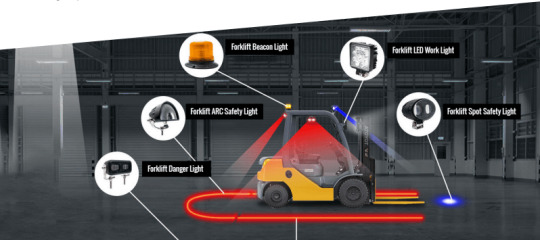
A forklift offers a pretty open view to the person operating it. However, many crucial viewpoints are blocked off from the driver's point of view when using it. This can lead to risky situations that can cause accidents. Forklift safety lights are used to keep a close eye on these blind spots and shed illumination. In addition, drivers often have to work in places with dim or little-to-no lights. In these situations, forklift safety lights are a savior. Our verdict on whether the forklift safety light system is a fad or a necessity? An absolute requirement, of course! These safety lights can help you reduce and even avoid serious injuries for workers on the clock.
➢ Types of Forklift Safety Light Systems for Your Use
Which forklift safety lights by SharpEagle will offer you the best deal? Keep reading to know more!
• Forklift Arc Light
Get a high-power LED with a beam projection on the ground. The tempered glass cover offers you dual protection from any external damage. The forklift arc light is also 100 percent dust, water, and quakeproof.

• Forklift Red Danger Light
The Red Danger Light is a gamechanger. It helps pedestrians steer clear of` the dangerously swinging movements of a forklift. Avoid countless injuries with this hefty piece of innovative technology. The alert set system offers high-power LED lights and the ability to withstand extreme temperatures.

• Forklift Laser Light
Get laser beam projection that indicates the exact fork position. You get to increase workers' productivity who will work better in a safe and secure environment. That is a win-win for sure!

• Forklift Blue Spot Light
The Blue Spot Light is ideal for alerting other cars and pedestrians. It also offers a much better perspective on blind spots.

• Forklift Blue Arrow Light
The Blue Arrow Light offers 3W LED lights to protect bystanders and drivers from engaging in accidental maneuvers with the forklift.

• Overhead crane light
SharpEagle's overhead crane light ensures that the hook is in the right spot. This helps bystanders stay safe when the crane is moving. The 72 W overhead crane light serves the purpose effectively even in extreme temperatures.
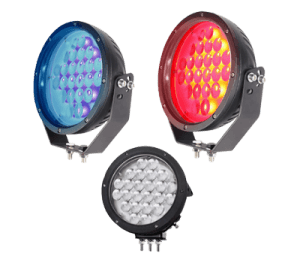
• Forklift warning light
The high-power Forklift warning light (Forklift beacon light), protected with a durable glass cover and a two-year warranty, offers protection to both pedestrians and operators.

Read More : 10 principles of Forklift operational safety
➢ Why You Should Go for SharpEagle for All Your Safety Light Requirements
Are you looking for a trustworthy organization that understands and implements safety systems as a principle? Then, you have come to the right place! SharpEagle is the one-stop for all things safety and security. If you are looking for top-notch forklift safety lights in the market, look no further. SharpEagle's products lay waste to any who dare to compete with them. Expect only the best with the most modern, up-to-date mechanisms and complex safety measures. SharpEagle is the go-to shop for all corporations that require safety lighting systems. They understand your need to cover all blind spots to avoid accidents. Companies swear by SharpEagle products for safekeeping their workers from all possible bodily injuries. You can choose from an array of forklift safety light systems to suit your needs. From unique designs to workability, all products by SharpEagle are unparalleled by its competitors. So you can safely trust this organization with all your needs.
➢ Opt for a Safe and Secure Warehouse Today
Industries should employ all safety regulations possible. It will help ensure that every one of your workers feels secure when they operate big machinery like forklifts. You should alleviate your worries by choosing nothing but the best. SharpEagle's range of products will ensure that you can avoid all liabilities on the site. Always encourage a safe and nurturing place of business with premium safety products from SharpEagle.
#Forklift Arc Light#forklift red zone light#forklift safety lights red#Forklift arc safety lights#Forklift Red danger light#Forklift Arc Safety Light#red zone danger area warning light#red zone light for forklift#LED forklift arc light#arc safety solutions#Forklift Red zone warning light#Forklift Red zone Pedestrian safety warning light#LED Forklift red zone warning light#Forklift red zone danger area warning light
0 notes
Text
Importance of Red Zone Danger Area Warning Lights

Forklifts serve a vital role in many industries for material handling and transportation. These versatile machines are used in warehouses, factories, construction sites, and many other settings to lift and move heavy loads from one location to another. Forklifts are equipped with long, metal prongs called forks, which lift and move pallets, crates, and other packaged goods. The forks are mounted on a mast, which can be raised and lowered using hydraulic controls. The operator sits in a cab at the front of the forklift and uses powers to manoeuvre the vehicle and manipulate the forks.
However, forklifts are not devoid of safety threats to the goods, equipment, pedestrians, and the operator. OSHA records 34,900 fatal and 61,800 non-fatal injuries caused by forklifts annually. Below listed are the primary hazards that forklifts pose across different industries.
Safety Hazards of Forklifts in Industries
Forklifts are prone to several hazards due to their size and working conditions, as listed below:
Collisions
Forklifts can collide with other vehicles, pedestrians, or stationary objects, which can cause serious injuries or fatalities. Operators should be trained to avoid collisions by paying attention to their surroundings and following safety protocols.
Falls
Falls from a forklift can occur if the operator loses control or if the forklift overturns. Operators should be trained appropriately to use the forklift safely. The forklift should be maintained in good working order to reduce the risk of falls.
Struck-by accidents
Forklifts can cause injuries if workers are struck by the vehicle or by objects being moved by the forklift. Operators should be trained to use caution while operating the forklift and to be aware of their surroundings at all times.
Caught-in/between accidents
Workers can be injured if they are caught between the forklift and another object or if they are caught in moving parts of the forklift. Operators should be trained to keep their hands and feet clear of moving parts and to use caution when driving the forklift.
Eradicating Low-Light Forklift Hazards
One of the common factors in the hazards listed above is the lack of visibility and proper warning signs for the crew, compromising the safety of on-ground pedestrians. This is where the LED lights for forklifts come in. Forklift safety lights are an essential safety feature that can help improve visibility and reduce the risk of accidents on the job. These lights are often used on forklifts, material handling equipment, and other industrial vehicles to improve visibility and alert other workers to the car's presence.
Primarily used in industries like logistics and large-scale warehouses, there are several different types of forklift safety lights, including headlights, tail lights, turn signals, and warning lights. Forklift safety lights are essential in low-light or poorly-lit environments, such as warehouses and factories. They can help improve visibility and make it easier for operators to navigate the workplace. They can also help alert other workers to the presence of the forklift, which can help reduce the risk of collisions and different types of accidents.
In addition to improving visibility and safety, forklift safety lights can also help improve efficiency on the job. By making it easier for operators to see their surroundings and navigate the workplace, safety lights can help reduce the risk of delays and accidents, which can help improve overall productivity.
Thereby, LED lights for forklifts are an essential safety feature that can help improve visibility and reduce the risk of accidents on the job. Employers should ensure that their forklifts are equipped with appropriate safety lights, and workers should be aware of the importance of using them to improve workplace safety and efficiency.
Introducing the Forklift Red Zone Light
Red Danger Warning Light creates a safety perimeter around the forklift to reduce the risk of foot injuries and collisions. These lights are mounted on either side of the vehicle. They project a bright red beam around the forklift, providing a visual cue to the crew and pedestrians to keep safe distance from an operating forklift to avoid accidents and injuries.
Technical Specifications of SharpEagle’s Forklift Red Zone Warning Lights
Enhanced safety signalling with potent red LEDs
Optional line beam for versatile lighting.
Waterproof, dustproof, and quakeproof protection
Durability with aluminium die-cast housing and stainless steel bracket.
Double-insulated silicon rubberized wire for safety.
High-Power LED Array: Osram LED 6pcs*3w
Ground Illumination: 200lux @2.5m
Voltage Options: 10~80V DC or 10-110V DC (Customised)
Long Lifespan: 50,000 hours
Colour Choices: Blue or Red
Working Temperature Range: -40°C ~ 80°C
Compact Design: 150*60*57mm
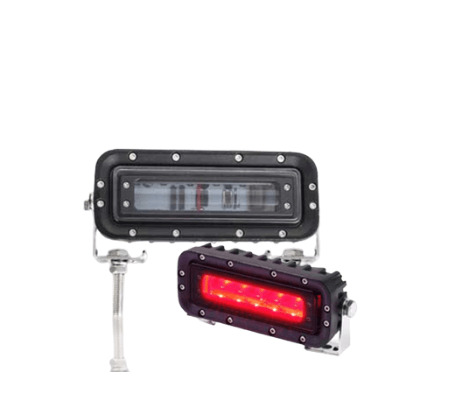
Importance of Forklift Red Zone Light for Your Industry
Prevents Forklift Accidents
The red danger light prevents forklift accidents by providing warning to the pedestrians from any direction. This is particularly useful in multiple blind corners and behind structures in busy workplaces. Primarily, these lights are useful in providing safety against collisions with the forklift's rear-end swing. Beside securing pedestrians and protecting them from being run-over, these forklift warning lights also secure the goods and merchandise transported with the forklift.
Clear Visibility Over Long Distances
Owing to the working conditions in industries and large warehouses, the workers might encounter several blindspots. Due to the sharp turns in several industries, pedestrians might fail to notice an approaching forklift before the intersection. Furthermore, workers are used to working in extremely noisy conditions, due to which a warning alarm might often be ineffectual. In such cases, the bright LED light used in the forklift red zone warning lights can serve as a reliable visual cue for an approaching forklift. The colour red is proven to scatter the least and is hence visible over long distances to warn the pedestrians.
Increased Productivity
Assured protection from forklifts allow workers to move heavy loads quickly and efficiently, significantly increasing productivity. Thus, forklift red danger lights improve the efficiency of material handling and transportation processes, which is especially important in fast-paced industry environments.
Employers should ensure that their forklifts are equipped with appropriate red danger lights, and workers should be aware of the importance of using them to improve workplace safety and efficiency. Proper use of forklift red danger lights can help reduce the risk of accidents and injuries on the job and can help improve overall safety in the workplace.
Partner with SharpEagle for Smart Safety Solutions for Your Forklift Operations
The benefits discussed above highlight the importance of investing in a good and reliable model of red zone danger light for your workplace. SharpEagle is a leading safety and efficiency solutions provider in the GCC and the UK. We are end-to-end safety consultants for your company. Our experts offer services like site inspection for customised forklift safety and lighting solutions. Our forklift red danger light undergoes severe tests to ensure its reliable performance. We constantly keep updating the model with the latest technological trends to optimise the safety standards for your crew, goods, and the forklift itself. Beside manufacturing and installation, our team also conducts maintenance checks for warranted safety in your forklift operations.
To know more about our forklift red zone light, visit our website or book a free consultation call with our experts to optimise your forklift safety today!
#Forklift Arc Light#forklift red zone light#forklift safety lights red#Forklift arc safety lights#Forklift Red danger light#Forklift Arc Safety Light#red zone danger area warning light#red zone light for forklift#LED forklift arc light#arc safety solutions#Forklift Red zone warning light#Forklift Red zone Pedestrian safety warning light#LED Forklift red zone warning light#Forklift red zone danger area warning light
0 notes
Text
How To Enhance Warehouse Traffic Safety with Forklift Safety Solutions
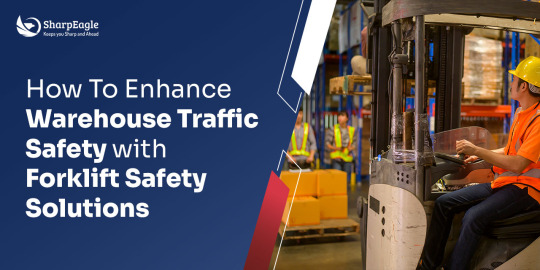
Warehouses are bustling environments with a constant flow and traffic of forklifts, trucks, and pedestrians. This is why increasing warehouse traffic safety has become essential to accident mitigation and maintenance of an efficient workflow. With the right know-how, technologies, and adherence to safety standards, every business can create a secure space — the one that promotes productivity without compromising safety.
As a leader in custom industrial safety solutions, SharpEagle offers innovative tools like advanced cameras and other warehouse traffic systems to address common warehouse hazards effectively. In this guide, we’ll explore the importance of traffic safety in warehouses, common challenges, and actionable solutions.
Importance of Traffic Safety in Warehouse
Traffic safety in warehouses is about more than compliance with OSHA standards; it’s about protecting lives and ensuring operational efficiency.
Accidents caused by poor traffic control and failing to implement forklift safety regulations can lead to serious injuries, equipment damage, and financial losses.
1. Injuries : Fractures, head trauma and even fatalities can occur as a result of poor warehouse traffic management. Such injuries disrupt not only the lives of the affected workers but also the productivity and morale of the entire team. Recovery times and medical treatments can extend over weeks or months, causing significant workforce challenges and strains to cover for the missing workforce.
2. Equipment Damage : Damaged equipment often leads to expensive repairs or replacements. Such incidents happen as a result of collisions or improper use, directly affecting operational capacity. From the operational perspective, there are also delays and increased downtime, further hampering efficiency.
3. Financial Losses: The financial repercussions of accidents in a warehouse can be far-reaching. Expenses related to medical care, equipment repairs, and potential legal claims can strain budgets. Prolonged downtime caused by accidents further amplifies losses, reducing the overall profitability of the operation. These factors highlight the critical need for stringent traffic safety measures in warehouses.

Hazards in the Warehouse
Warehouses are filled with potential hazards, especially when it comes to traffic management. Common risks include:
Blind spots: Collisions occur due to limited visibility around corners and shelves.
Pedestrian and forklift interactions: A lack of defined pathways increases the risk of accidents.
Poor lighting: Dimly lit areas can obscure obstacles, leading to mishaps.
Key Risks and Hazards of Warehouse Traffic
1. Blind Spots and Collisions: Blind spots around shelving units and corners often lead to collisions. This risk can be mitigated with tools like SharpEagle’s Safe Zone Corner Guard, which enhances visibility at blind corners.
This device provides visual and audio warnings triggered when motion is detected on both sides of the corner. Its easy snap-on installation and customisable audio settings make it the perfect safeguard for blind corners. Equipped with loud, distinct audio alerts and high-intensity LED lights, the Safe Zone Corner Guard ensures maximum visibility and awareness, making it a comprehensive solution for collision detection and avoidance.
2. Pedestrian and Forklift Interactions: Forklifts and pedestrians share warehouse spaces, creating significant risks. SharpEagle addresses these challenges with innovative solutions like advanced cameras and pedestrian warning systems. Without defined pathways and effective warning mechanisms, the potential for accidents rises sharply.
3. Poor Visibility in Dimly Lit Areas: Inadequate lighting reduces visibility, increasing the risk of errors and collisions. Proper lighting solutions, like SharpEagle’s high-intensity forklift traffic LED lights, ensure a safer work environment.
Ways to Improve Your Warehouse Traffic Safety
Enhancing traffic safety in a warehouse involves implementing strategic measures tailored to address specific risks.
1. Prioritising Path Design and Layout : Efficient warehouse design is fundamental to traffic safety. Ensure clearly marked, one-way pathways for forklifts and pedestrians. Integrate designated crossing zones to minimise accidental interactions and streamline traffic flow.
2. Traffic Signs, Signals, and Safety Equipment : Employ reflective signs, LED indicators, and physical barriers to enhance navigation. Strategically place these tools in high-risk areas to ensure they’re easily visible to all workers.
3. Warehouse Traffic Flow: Optimise traffic flow by strategically positioning loading and unloading zones near operational hotspots. This reduces unnecessary forklift travel, minimising congestion and risk.
4. Blind Spots: SharpEagle’s Safe Zone Corner Guard is an ideal solution for mitigating risks associated with blind corners. This innovative device provides synchronised audio and visual alerts when motion is detected on both sides of a corner. High-intensity LED lights and customisable sound settings ensure maximum awareness, significantly reducing collision risks.
OSHA’s Guidelines for Warehouse Traffic Safety
Adhering to OSHA standards is crucial for maintaining a safe and compliant warehouse environment. These guidelines provide a structured approach to minimising risks and ensuring the safety of workers, equipment, and goods. Below are key warehouse safety rules OSHA recommends:
Clear Marking of Aisles and Pathways: All aisles and pathways should be visibly marked to guide forklift operators and pedestrians effectively. This reduces confusion and the risk of accidents.
Regular Maintenance of Forklifts: Ensuring forklifts are in good working condition is vital. Routine inspections can identify potential issues before they become major problems, aligning with OSHA’s focus on preventive measures.
Operator Certification Programs: Only trained and certified operators should be allowed to use forklifts. OSHA mandates proper training to ensure operators are equipped to handle equipment safely and efficiently.
Proper Use of Safety Equipment: Equip forklifts with necessary safety tools like cameras, warning lights, and alarms. OSHA encourages the integration of advanced safety technologies to address modern workplace challenges.
Defined Traffic Management Plans: Implement traffic rules within the warehouse, such as speed limits and right-of-way protocols. These guidelines help in creating a more organised and safer environment.
Warehouse Safety Checklist for Forklifts
Operating forklifts safely in a warehouse requires vigilance and adherence to best practices. Here is a warehouse safety checklist to ensure the safety of both operators and pedestrians:
Pay Attention to Forklift Stability: Operate forklifts at moderate speeds and avoid abrupt turns to maintain stability. Instability increases the risk of tipping, especially when carrying heavy loads.
Forklift Operator Certification: Only certified operators should handle forklifts. Certification ensures the operator understands safety protocols and the mechanics of the vehicle.
Pedestrians Have the Right of Way: Establish clearly defined pedestrian zones with proper markings and crossing points to reduce risks of interaction between forklifts and people.
Be Aware of the Lift Capacity: Overloading a forklift compromises its balance and can lead to accidents. Always adhere to the specified lift capacity guidelines.
Know Your Blind Spots: Equip forklifts with SharpEagle’s camera systems, such as the 360-degree Bird-Eye View Camera, to eliminate blind spots and improve situational awareness.
Don’t Travel with an Elevated Load: Always lower loads to improve the operator’s visibility and the forklift’s balance. Elevated loads obscure vision and increase the risk of tipping.
Forklift Speed Needs to be Moderated: Enforce speed limits to prevent reckless operation. Speeding in confined warehouse spaces can lead to catastrophic accidents.
Implement Forklift Marking Systems: Use LED safety lights and warning markers to signal forklift movement, ensuring nearby workers are alerted.
Use a Forklift Safety Checklist: Conduct regular inspections of forklifts to ensure they are in optimal working condition. A checklist helps identify potential issues before they escalate into accidents.
How SharpEagle Forklift Camera and Lighting Solutions Improve Warehouse Safety
How Forklift Safety Lighting Enhances Visibility
SharpEagle’s advanced lighting solutions are specifically designed to tackle the challenges of poor visibility in dimly lit areas. Our high-intensity LED warning lights and spotlights not only illuminate the forklift’s path but also serve as clear visual cues for pedestrians, ensuring their safety. By integrating these lighting solutions into warehouse operations, businesses can significantly reduce collision risks and improve overall efficiency.
Advanced Camera Systems for Forklift Safety
SharpEagle offers a range of camera systems designed for forklift operations:
Forkview Camera System: Ideal for improving visibility during loading and unloading.
360-Degree Bird-Eye View Camera System: Provides a comprehensive view of the forklift’s surroundings, reducing blind spots.
These systems offer real-time monitoring, helping operators navigate safely and efficiently.
Integration with Warehouse Operations
SharpEagle’s safety solutions integrate seamlessly with existing warehouse systems, offering advanced tools like real-time monitoring cameras, pedestrian detection systems, and high-intensity LED lights. These technologies provide real-time data, reduce operational blind spots, and support proactive decision-making to enhance overall safety protocols and operational efficiency.
Why Choose SharpEagle Forklift Safety Solutions?
At SharpEagle, we understand the unique challenges of warehouse traffic management. Our customised solutions, including cameras, lighting, and pedestrian warning systems, are designed to enhance safety and efficiency. With a proven track record and support network across the Middle East, India, and the UK, we’re your trusted partner in safety.
Conclusion
Traffic safety is not just about compliance – it’s about creating a secure, productive environment for your team. With the right tools, strategies, and expert guidance from SharpEagle, you can mitigate risks and optimise operations. Book a free consultation to discuss warehouse safety solutions or visit our product page and to explore advanced forklift safety cameras and lighting systems.
#warehouse traffic safety#traffic safety warehouse#warehouse safety tips#warehouse safety checklist#Warehouse Safety Rules#forklift safety regulations#OSHA standards
0 notes
Text
How To Enhance Warehouse Traffic Safety with Forklift Safety Solutions
Warehouses are bustling environments with a constant flow and traffic of forklifts, trucks, and pedestrians. This is why increasing warehouse traffic safety has become essential to accident mitigation and maintenance of an efficient workflow. With the right know-how, technologies, and adherence to safety standards, every business can create a secure space — the one that promotes productivity without compromising safety.
As a leader in custom industrial safety solutions, SharpEagle offers innovative tools like advanced cameras and other warehouse traffic systems to address common warehouse hazards effectively. In this guide, we’ll explore the importance of traffic safety in warehouses, common challenges, and actionable solutions.
Importance of Traffic Safety in Warehouse
Traffic safety in warehouses is about more than compliance with OSHA standards; it’s about protecting lives and ensuring operational efficiency.
Accidents caused by poor traffic control and failing to implement forklift safety regulations can lead to serious injuries, equipment damage, and financial losses.
1. Injuries : Fractures, head trauma and even fatalities can occur as a result of poor warehouse traffic management. Such injuries disrupt not only the lives of the affected workers but also the productivity and morale of the entire team. Recovery times and medical treatments can extend over weeks or months, causing significant workforce challenges and strains to cover for the missing workforce.
2. Equipment Damage : Damaged equipment often leads to expensive repairs or replacements. Such incidents happen as a result of collisions or improper use, directly affecting operational capacity. From the operational perspective, there are also delays and increased downtime, further hampering efficiency.
3. Financial Losses: The financial repercussions of accidents in a warehouse can be far-reaching. Expenses related to medical care, equipment repairs, and potential legal claims can strain budgets. Prolonged downtime caused by accidents further amplifies losses, reducing the overall profitability of the operation. These factors highlight the critical need for stringent traffic safety measures in warehouses.
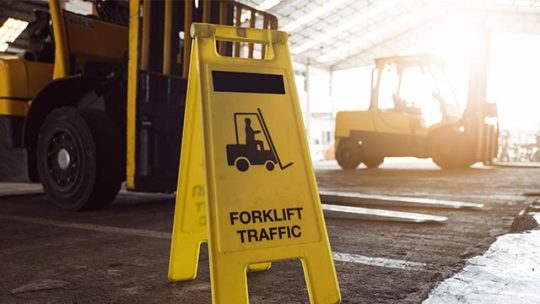
Hazards in the Warehouse
Warehouses are filled with potential hazards, especially when it comes to traffic management. Common risks include:
Blind spots: Collisions occur due to limited visibility around corners and shelves.
Pedestrian and forklift interactions: A lack of defined pathways increases the risk of accidents.
Poor lighting: Dimly lit areas can obscure obstacles, leading to mishaps.
Key Risks and Hazards of Warehouse Traffic
1. Blind Spots and Collisions: Blind spots around shelving units and corners often lead to collisions. This risk can be mitigated with tools like SharpEagle’s Safe Zone Corner Guard, which enhances visibility at blind corners.
This device provides visual and audio warnings triggered when motion is detected on both sides of the corner. Its easy snap-on installation and customisable audio settings make it the perfect safeguard for blind corners. Equipped with loud, distinct audio alerts and high-intensity LED lights, the Safe Zone Corner Guard ensures maximum visibility and awareness, making it a comprehensive solution for collision detection and avoidance.
2. Pedestrian and Forklift Interactions: Forklifts and pedestrians share warehouse spaces, creating significant risks. SharpEagle addresses these challenges with innovative solutions like advanced cameras and pedestrian warning systems. Without defined pathways and effective warning mechanisms, the potential for accidents rises sharply.
3. Poor Visibility in Dimly Lit Areas: Inadequate lighting reduces visibility, increasing the risk of errors and collisions. Proper lighting solutions, like SharpEagle’s high-intensity forklift traffic LED lights, ensure a safer work environment.
Ways to Improve Your Warehouse Traffic Safety
Enhancing traffic safety in a warehouse involves implementing strategic measures tailored to address specific risks.
1. Prioritising Path Design and Layout : Efficient warehouse design is fundamental to traffic safety. Ensure clearly marked, one-way pathways for forklifts and pedestrians. Integrate designated crossing zones to minimise accidental interactions and streamline traffic flow.
2. Traffic Signs, Signals, and Safety Equipment : Employ reflective signs, LED indicators, and physical barriers to enhance navigation. Strategically place these tools in high-risk areas to ensure they’re easily visible to all workers.
3. Warehouse Traffic Flow: Optimise traffic flow by strategically positioning loading and unloading zones near operational hotspots. This reduces unnecessary forklift travel, minimising congestion and risk.
4. Blind Spots: SharpEagle’s Safe Zone Corner Guard is an ideal solution for mitigating risks associated with blind corners. This innovative device provides synchronised audio and visual alerts when motion is detected on both sides of a corner. High-intensity LED lights and customisable sound settings ensure maximum awareness, significantly reducing collision risks.
OSHA’s Guidelines for Warehouse Traffic Safety
Adhering to OSHA standards is crucial for maintaining a safe and compliant warehouse environment. These guidelines provide a structured approach to minimising risks and ensuring the safety of workers, equipment, and goods. Below are key warehouse safety rules OSHA recommends:
Clear Marking of Aisles and Pathways: All aisles and pathways should be visibly marked to guide forklift operators and pedestrians effectively. This reduces confusion and the risk of accidents.
Regular Maintenance of Forklifts: Ensuring forklifts are in good working condition is vital. Routine inspections can identify potential issues before they become major problems, aligning with OSHA’s focus on preventive measures.
Operator Certification Programs: Only trained and certified operators should be allowed to use forklifts. OSHA mandates proper training to ensure operators are equipped to handle equipment safely and efficiently.
Proper Use of Safety Equipment: Equip forklifts with necessary safety tools like cameras, warning lights, and alarms. OSHA encourages the integration of advanced safety technologies to address modern workplace challenges.
Defined Traffic Management Plans: Implement traffic rules within the warehouse, such as speed limits and right-of-way protocols. These guidelines help in creating a more organised and safer environment.
Warehouse Safety Checklist for Forklifts
Operating forklifts safely in a warehouse requires vigilance and adherence to best practices. Here is a warehouse safety checklist to ensure the safety of both operators and pedestrians:
Pay Attention to Forklift Stability: Operate forklifts at moderate speeds and avoid abrupt turns to maintain stability. Instability increases the risk of tipping, especially when carrying heavy loads.
Forklift Operator Certification: Only certified operators should handle forklifts. Certification ensures the operator understands safety protocols and the mechanics of the vehicle.
Pedestrians Have the Right of Way: Establish clearly defined pedestrian zones with proper markings and crossing points to reduce risks of interaction between forklifts and people.
Be Aware of the Lift Capacity: Overloading a forklift compromises its balance and can lead to accidents. Always adhere to the specified lift capacity guidelines.
Know Your Blind Spots: Equip forklifts with SharpEagle’s camera systems, such as the 360-degree Bird-Eye View Camera, to eliminate blind spots and improve situational awareness.
Don’t Travel with an Elevated Load: Always lower loads to improve the operator’s visibility and the forklift’s balance. Elevated loads obscure vision and increase the risk of tipping.
Forklift Speed Needs to be Moderated: Enforce speed limits to prevent reckless operation. Speeding in confined warehouse spaces can lead to catastrophic accidents.
Implement Forklift Marking Systems: Use LED safety lights and warning markers to signal forklift movement, ensuring nearby workers are alerted.
Use a Forklift Safety Checklist: Conduct regular inspections of forklifts to ensure they are in optimal working condition. A checklist helps identify potential issues before they escalate into accidents.
How SharpEagle Forklift Camera and Lighting Solutions Improve Warehouse Safety
How Forklift Safety Lighting Enhances Visibility
SharpEagle’s advanced lighting solutions are specifically designed to tackle the challenges of poor visibility in dimly lit areas. Our high-intensity LED warning lights and spotlights not only illuminate the forklift’s path but also serve as clear visual cues for pedestrians, ensuring their safety. By integrating these lighting solutions into warehouse operations, businesses can significantly reduce collision risks and improve overall efficiency.
Advanced Camera Systems for Forklift Safety
SharpEagle offers a range of camera systems designed for forklift operations:
Forkview Camera System: Ideal for improving visibility during loading and unloading.
360-Degree Bird-Eye View Camera System: Provides a comprehensive view of the forklift’s surroundings, reducing blind spots.
These systems offer real-time monitoring, helping operators navigate safely and efficiently.
Integration with Warehouse Operations
SharpEagle’s safety solutions integrate seamlessly with existing warehouse systems, offering advanced tools like real-time monitoring cameras, pedestrian detection systems, and high-intensity LED lights. These technologies provide real-time data, reduce operational blind spots, and support proactive decision-making to enhance overall safety protocols and operational efficiency.
Why Choose SharpEagle Forklift Safety Solutions?
At SharpEagle, we understand the unique challenges of warehouse traffic management. Our customised solutions, including cameras, lighting, and pedestrian warning systems, are designed to enhance safety and efficiency. With a proven track record and support network across the Middle East, India, and the UK, we’re your trusted partner in safety.
Conclusion
Traffic safety is not just about compliance – it’s about creating a secure, productive environment for your team. With the right tools, strategies, and expert guidance from SharpEagle, you can mitigate risks and optimise operations. Book a free consultation to discuss warehouse safety solutions or visit our product page and to explore advanced forklift safety cameras and lighting systems.
#warehouse traffic safety#traffic safety warehouse#warehouse safety tips#warehouse safety checklist#Warehouse Safety Rules#forklift safety regulations#OSHA standards
0 notes
Text
Ultimate Guide to Forklift Truck Accidents and Their Solutions
Forklift truck accidents are a significant concern in industrial settings across the UAE and the United Kingdom. According to the British Safety Council forklift accident statistics, 1,300 individuals are involved in forklift accidents every year in Britain. Addressing forklift safety is important to protect employees and avoid legal and financial issues for businesses. Companies that prioritise safety create trust with their workers and customers while adhering to health and safety standards.
This blog aims to highlight 10 fatal forklift accident causes and provide precautions to prevent such mishaps.
Understanding Forklift Accidents
What Are Forklift Accidents?
Forklift accidents refer to incidents involving forklifts that result in injuries or fatalities, often occurring in industrial settings such as warehouses and construction sites. These accidents can occur due to a variety of factors, including operator error, mechanical failure, or unsafe working conditions. The most common types of forklift accidents include rollovers, pedestrian collisions, mechanical failures, and falling loads.
Statistical Overview
Forklift accidents are a major safety concern worldwide, with OSHA estimating 35,000 to 62,000 injuries annually. Serious injuries involving pedestrians account for 34,900 or 36% fatalities every year. The manufacturing sector has the highest fatality rate at 42.5%, followed by construction at 23.8%. Other high-risk industries include transportation and warehousing, where nonfatal incidents are common due to the frequent use of forklifts for moving goods.
Common Causes of Forklift Accidents
Operator Error is one of the leading causes of warehouse forklift accidents, often resulting from distractions, poor judgement, or failure to follow safety protocols.
Mechanical Failures can occur due to inadequate maintenance or faulty equipment, leading to unexpected malfunctions that compromise safety during operation.
A Poorly Designed Workplace Layout can create hazards such as narrow aisles, insufficient signage, and obstacles, increasing the risk of collisions and accidents.
Insufficient Training and Lack of Supervision can leave operators unprepared to handle the complexities of forklift operation, contributing significantly to the likelihood of accidents.

Pedestrian Impacts
Pedestrian impacts are frequently caused by operator inattention, poor warehouse layout, and a lack of clear pedestrian pathways.
To prevent this:
Implement physical barriers to separate pedestrian walkways from forklift paths
Use blue spotlights or warning light signal
Ensure operators receive thorough training on pedestrian awareness
Additionally, installing forklift cameras can enhance visibility and safety for both operators and pedestrians.
Lack Of Operator Training
Insufficient training often leads to improper handling of forklifts, increasing the likelihood of accidents. Operators may not be aware of safety protocols or how to manage loads effectively.
Providing comprehensive training programs is essential, which include:
Safe operation practices
Load management
Emergency procedures
Regular refresher courses can help reinforce safety knowledge and skills among operators.
Falling Loads
Falling loads typically result from improper loading techniques, unsecured loads, or moving with an elevated mast.
To prevent falling loads:
Ensure that all loads are properly secured and balanced before movement
Avoid raising the load unnecessarily
Tilt the mast back when transporting items
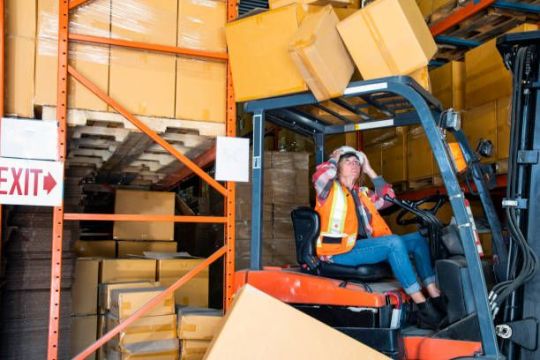
Truck Falling Off A Trailer Or Dock
Trucks can fall off docks or trailers due to improper loading practices, lack of safety barriers, or operator error during loading and unloading processes.
To prevent trucks from rolling off docks:
Install dock plates and barriers
Implement strict loading protocols
Ensure that operators are trained in safe loading practices
Personnel Falling From Forks
Personnel falling from forks often occurs when workers ride on the forks or platforms without proper safety measures in place.
Implement forklift accident prevention like
Establishing a strict policy against riding on forks
Providing adequate training on safe working practices
Blocked Field of View for the Operator
A blocked view can occur when loads are too high or when the operator's line of sight is obstructed by equipment or materials.
To avoid a blocked field of view for the operator:
Operators should be trained to keep loads as low as possible while driving
Use spotters when visibility is compromised
Installing forklift safety cameras and mirrors can also improve visibility in low-light conditions or blind spots.

Mechanical Failures
Mechanical failures may result from inadequate maintenance, worn-out parts, or failure to conduct regular inspections.
To prevent mechanical failures:
Regular maintenance schedules should be established, including pre-shift inspections and routine servicing of forklifts
Operators should be trained to identify potential mechanical issues before they lead to accidents
Emissions Poisoning
Emissions poisoning can occur in poorly ventilated areas where forklifts emit harmful gases such as carbon monoxide.
To avoid emissions poisoning:
Ensure proper ventilation in work areas where forklifts operate
Use electric forklifts instead of gas-powered ones
Crushed By Forklift
Being crushed by a forklift usually happens due to operator error, lack of awareness around moving equipment, or inadequate safety measures in place for pedestrian protection.
To avoid these tragic accidents:
Implement strict safety protocols that include designated pedestrian pathways
Use warning signals for moving forklifts
Ensure operators are trained in situational awareness
Impact Of Forklift Accidents
Warehouse forklift accidents have significant impacts on workplace safety and operations. They can result in fatalities and serious injuries, affecting not only the individuals involved but also their families and coworkers. The economic consequences are substantial, leading to increased costs for businesses due to medical expenses, legal fees, and lost productivity.
Additionally, pedestrian safety is a major concern, as many accidents involve individuals who are not operating the forklift. Regulatory compliance becomes more challenging following accidents, often resulting in investigations and potential fines. Furthermore, the need for comprehensive training and awareness programs is critical, as many accidents could be prevented with better education on safe operating practices.
Overall, the repercussions of forklift truck accidents highlight the necessity for stringent safety measures in industrial environments.
Preventative Measures For Forklift Accidents
Operator Training And Certification
Ensuring that forklift operators are thoroughly trained and certified is critical for maintaining safety in environments where explosion-proof equipment is necessary. Compliance with regulatory requirements is essential for effective training. SharpEagle recognises the importance of such comprehensive training programs that not only meet regulatory requirements but also equip operators with the skills to effectively utilise advanced Forklift Safety Solutions.
Equipment Maintenance
Establish regular inspection schedules to pick up and address potential issues with forklifts. Common maintenance checks should include brakes, tires, lights, and safety features to ensure optimal performance.
Workplace Design And Layout
Design the workplace with clear pathways and appropriate signage to guide operators and pedestrians. Establish dedicated zones for forklifts and pedestrians to minimise collision risks.
Technology-Based Solutions
Implement safety cameras and sensors on forklifts to enhance visibility. Utilise real-time monitoring systems to track operations and alert supervisors to unsafe behaviours or conditions. A few technology-based products include:
Forklift Cameras
The forklift camera systems can be mounted in various locations on the forklift, such as the overhead guard or the carriage, allowing operators to see their forks and loads more clearly. The system is equipped with advanced features, including high-resolution imaging, a wide temperature range, wireless operation, and many more. A standout product for real-time monitoring is SharpEagle's Forkview Camera System, which significantly enhances operator visibility, particularly in blind spots.
Forklift Lights
Forklift safety lights are engineered to improve visibility and awareness in busy work environments. Notably, the Arrow Light projects a bright directional arrow onto the ground to indicate the approach of a forklift. Visual cue by these lights enhance pedestrian awareness and helps prevent collisions.
Other Forklift Safety Solutions
Other safety solutions, like the forklift anti-collision system, offer automatic warnings to avoid collisions during operations. Regular safety training further reinforces best practices, creating a safer workplace overall.
Conclusion
Addressing forklift safety is pivotal for protecting employees and preventing serious accidents that can lead to injuries and financial costs for businesses. Implementing comprehensive training, regular equipment maintenance, optimised workplace design, and technology solutions can significantly reduce accident risks. Companies must adopt proactive measures like installing reliable forklift camera systems to create a culture of safety, ensuring the well-being of all workers.
For the best forklift camera solutions, partner with SharpEagle, the most trusted partner in the UAE. Our technology-based forklift safety solutions are meticulously designed to enhance operational safety in industrial environments. By integrating advanced products like SharpEagle’s forkview camera system, and safety lights into their operations, companies can significantly mitigate risks associated with forklift usage. Schedule a free consultation with SharpEagle’s experts for custom forklift safety solutions today!
#forklift truck accidents#forklifts accidents#forklift accident causes#Forklift Accident Statistics#forklift truck accident warehouse#forklift accident prevention#warehouse forklift accidents
0 notes
Text
Ultimate Guide to Crane Operation Safety
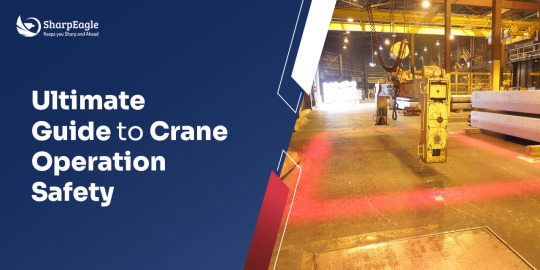
Cranes play a pivotal role in construction and industrial operations - these machines often operate in complex environments where safety is paramount. Crane operation safety policies not only protect workers but also enhance productivity and reduce costly disruptions.
At SharpEagle, we offer innovative safety solutions through which businesses can address critical safety challenges effectively.
In this guide we’ll explore the best practices, common hazards, and cutting-edge solutions to improve safety during crane operations.
Introduction to Crane Operation Safety
Cranes are indispensable tools for lifting and moving heavy loads across construction and industrial sites. However, improper handling of these powerful machines can result in severe accidents, injuries, and even fatalities.
According to the U.S. Bureau of Labor Statistics (BLS), between 2011 and 2021, an average of 44 crane-related fatalities occurred annually in the United States alone. A significant portion of those were caused by crane collapses, contact with power lines, and improper load handling.
Furthermore, the Occupational Safety and Health Administration (OSHA) reports that violations related to crane safety frequently rank among the most cited in workplace inspections. These statistics underscore the critical need for stringent safety measures and comprehensive training programs.
By prioritizing crane operation safety, businesses can protect lives, adhere to regulatory compliance, and ensure seamless and efficient workflows, ultimately fostering a safer and more productive work environment.
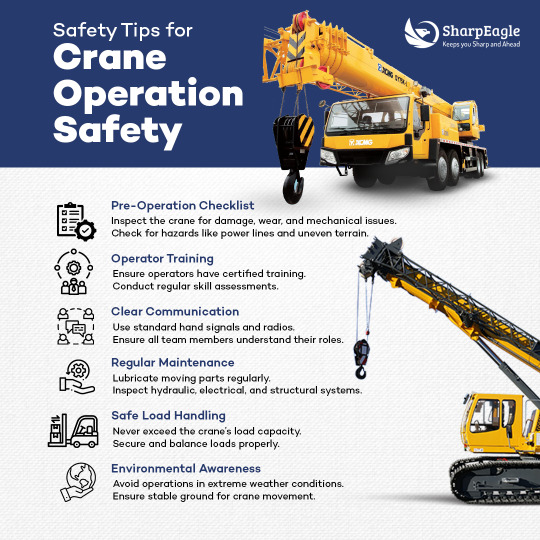
Common Hazards in Crane Operations
Understanding the risks associated with crane operations is critical for implementing effective safety measures. Cranes are powerful machines, but they can pose significant dangers when hazards are not properly managed.
Let’s explore the most common hazards and their potential impact:
Blind Spots
Restricted visibility is one of the leading causes of accidents in crane operations. Operators often struggle to see nearby personnel or equipment, increasing the likelihood of collisions. Blind spots can be particularly dangerous in crowded or high-activity areas where the risk of inadvertent contact is elevated.
Overloading
Exceeding the crane's load capacity is a common yet avoidable hazard. Overloading can lead to catastrophic consequences, such as the crane tipping over or structural failure. These incidents not only endanger the operator but pose significant risks to on-ground staff and surrounding equipment too.
Mechanical Failures
Cranes are complex pieces of machinery that require regular maintenance to function safely and efficiently. Neglecting routine inspections or ignoring minor issues can result in mechanical failures, such as hoist malfunctions, broken cables, or faulty brakes. These failures can lead to dropped loads, equipment damage, and serious injuries.
Environmental Factors
External conditions, such as adverse weather or uneven terrain, can severely compromise crane stability. High winds, heavy rain, or icy surfaces increase the risk of accidents by reducing traction and making it harder to maintain control. Uneven ground can cause the crane to tilt, further jeopardizing its stability.
Types of Cranes and Their Specific Safety Considerations
Mobile Cranes: Require stable ground and careful load balancing.
Tower Cranes: Need secure assembly and wind resistance checks.
Overhead Cranes: Demand clear pathways and reliable hoisting mechanisms.
Why Crane Safety is Critical
Investing in crane safety minimizes risks and ensures seamless operations. Key benefits include:
Reduced Accidents: Proper safety measures protect workers and equipment.
Regulatory Compliance: Adhering to OSHA and ANSI standards will prevent legal penalties and save lives.
Enhanced Efficiency: Safe operations minimize downtime and increase productivity.
OSHA guidelines emphasize the importance of clearly marked pathways, certified operators, and regular equipment inspections, particularly for suspended loads.
In this guide, you can find out all about crane accident prevention!

Best Practices for Crane Operation Safety
There are some necessary steps every company should undertake to achieve optimal safety.
Pre-Operation Checklist
Before commencing any crane operation, it is crucial to conduct a thorough pre-operation inspection. This includes:
Crane Inspection: Examine the crane for any signs of wear, damage, or mechanical issues. Check cables, hooks, brakes, and other components to ensure they are in optimal condition.
Environmental Assessment: Evaluate the work area for potential hazards, such as overhead power lines, uneven terrain, or obstructions. Clear the workspace of unnecessary personnel and equipment.
Load Capacity Verification: Confirm that the crane’s load capacity is suitable for the intended operation. Ensure the load weight does not exceed the crane’s rated capacity.
Operator Training
Certified and experienced operators are the backbone of safe crane operations. To maintain high safety standards:
Ensure all crane operators undergo comprehensive training and certification programs.
Provide refresher courses to keep operators updated on the latest safety protocols and technology advancements.
Conduct regular skill assessments to verify competency and adherence to safety guidelines.
Establish Clear Communication Protocols
Effective communication is vital to prevent misunderstandings and accidents. Key measures include:
Standardized Signals: Use universally recognized hand signals and gestures for crane operations.
Reliable Tools: Equip operators and ground personnel with radios or other reliable communication devices.
Clear Instructions: Ensure all team members understand the operation plan and their respective roles.
Regular Maintenance
Preventive maintenance is a cornerstone of crane safety. Establish a routine maintenance schedule that includes:
Lubricating moving parts to reduce wear and tear.
Inspecting hydraulic systems, electrical components, and structural elements for integrity.
Addressing minor issues promptly to prevent larger mechanical failures.
Safe Load Handling Techniques
Proper load handling techniques are essential to avoid accidents and equipment damage. Follow these guidelines:
Avoid overloading the crane by adhering strictly to load capacity limits.
Use appropriate rigging techniques, ensuring slings, hooks, and other equipment are securely fastened.
Balance loads to prevent shifting during lifting and transport.
Environmental Awareness
External conditions significantly impact crane stability and safety. To mitigate environmental risks:
Monitor Weather Conditions: Avoid operations during high winds, heavy rain, or storms, as these can compromise crane stability and visibility.
Assess Ground Stability: Ensure the ground is level and firm enough to support the crane’s weight and movement.
Adjust Operations as Needed: Modify procedures to account for changing environmental factors, such as reduced visibility during fog or glare from direct sunlight.
Now we’ve covered the basics, but is there anything else that can get you further in your safety efforts? The answer may lie in the safety tech being used.
Let’s see how Sharp Eagle can help!
Spotlight on SharpEagle's Overhead Crane Safety Light
SharpEagle’s innovative Overhead Crane Safety Light is tackling visibility challenges with precision and efficiency. Designed for high-demand industrial environments, this safety tool offers unparalleled features to ensure secure and efficient crane operations.
Key Features of SharpEagle’s Overhead Crane Safety Light
High-Intensity LED Lights: These lights project clear, sharp lines on the ground, creating well-defined load boundaries and safety zones. This feature ensures workers can identify hazardous areas at a glance.
Collision Prevention: By clearly marking crane movement paths, the light helps alert workers to the crane's position, significantly reducing the risk of accidents and collisions.
Enhanced Low-Light Performance: SharpEagle’s lights are specifically designed to perform in dimly lit and high-activity environments, ensuring safety even in challenging lighting conditions.
Durability and Energy Efficiency: Built with robust materials, the lights are resistant to industrial wear and tear while consuming minimal energy, making them a sustainable safety solution.
Want to know more about overhead crane safety? This guide may prove useful!
Complementary Products from SharpEagle
SharpEagle offers a comprehensive range of products that can be used to further enhance crane operation safety.
Explosion-Proof Camera Systems: Ideal for hazardous environments, these cameras provide real-time monitoring, helping operators maintain situational awareness and prevent accidents.
Forklift Safety Solutions: SharpEagle’s anti-collision sensors and camera systems enhance safety by reducing blind spots and ensuring the operator has a clear view of their surroundings.
Zone Safety Lighting: These LED safety lights illuminate designated zones, guiding ground staff and minimizing risks associated with overhead crane operations.
Equip your workplace with SharpEagle’s innovative safety solutions today to create a safer, more productive environment. Visit our product pages and explore the full range of products designed to redefine industrial safety.
Choosing the Right Crane Safety Lights
When selecting crane safety lights, consider factors like:
Durability: Ensure lights can withstand tough industrial conditions.
Brightness: Opt for high-intensity LEDs for maximum visibility.
Ease of Installation: Choose solutions that integrate seamlessly with existing systems.
If you need more help on choosing the right lights, this article has a few more knowledge points!
Enhancing Safety with Cameras and Additional Tools
Advanced cameras complement crane safety by providing real-time monitoring and eliminating blind spots. SharpEagle’s solutions, such as 360-degree cameras and warning lights, create a safer workplace by enhancing operator awareness and improving communication during operations.
Crane operation safety is an investment in your team’s well-being and your business’s success. Enhance your safety protocols with SharpEagle’s cutting-edge crane safety lights and cameras. Contact us today for a free consultation and discover how our solutions can transform your operations.
#overhead crane safety#crane operation safety#Crane safety#overhead crane operation safety#crane operation safety rules#overhead crane operation safety rules#Crane Lifting Hazards#crane warning lights#led crane lights
0 notes
Text
Type and functions of Forklift Safety Lights

Transporting heavy loads can be conducted securely and efficiently through the assistance of forklifts, which serve as vital instruments of efficiency across various industries. Nevertheless, their usage in congested warehouses or industrial structures can pose hazards.
Among the array of safety features integrated into forklifts, safety lights are particularly crucial. This post will delve into seven specific types of forklift safety lights, elucidating their role in enhancing worker safety.
7 Types of forklift safety lights and their uses
Presented below are seven categories of forklift safety lights, each with its distinct functions. Understanding the purposes of these lights empowers operators and pedestrians to steer clear of accidents and injuries, promoting secure navigation around forklifts.
1. Forklift Arc Light
The forklift arc light is one of the prevalent safety lights incorporated into forklifts. Typically affixed to the front or rear of the forklift, this light emits a vibrant spot onto the ground, aligning with the forklift's travel direction.
The primary role of the forklift arc light is to notify pedestrians and fellow workers about the presence of an approaching forklift. The projector spot on the ground functions as a visual alert, signaling the proximity of a forklift and urging caution. This proactive measure helps avert unintended collisions and ensures that workers remain cognizant of their surroundings.
Product Features:
Tempered Glass Cover.
High power LED with High quality.
The high performance of 100% waterproof, dustproof & quakeproof.
Beam: Projector spot on the ground.
Ingress protection: IP-67
Warranty: 1 year
Double insulated silicon rubberized wire, which can bear very low & high temperatures.
Casting Aluminum Alloy Housing, the suitable design for heating elimination.
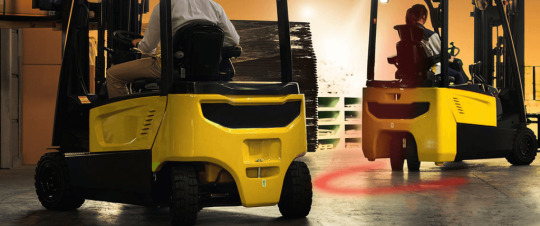
2. Forklift Red Danger Light
Forklifts come equipped with a vital safety feature known as the red danger light. Typically positioned on the front, back, or sides of the forklift, it comprises one or more conspicuous red lights. Designed for enhanced visibility, especially in low-light conditions.
The red hazard light serves as a clear warning signal, alerting individuals to the presence of the forklift. This is particularly crucial when the forklift is moving in reverse or operating in poorly lit areas. By notifying bystanders and other workers to steer clear of the forklift's path, this light significantly reduces the risk of accidents and mishaps.
Product Features:
Light source: High-power Osram LED 6pcs*3w
Operating Voltage:10-80V DC
LED power:18W
Double insulated silicon rubberized wire, Which can bear very low & high temperatures.
Material: Aluminium Die-Cast Housing, PC
Cover, Stainless Steel Bracket
Optional beam: line beam
Warranty: 1 year
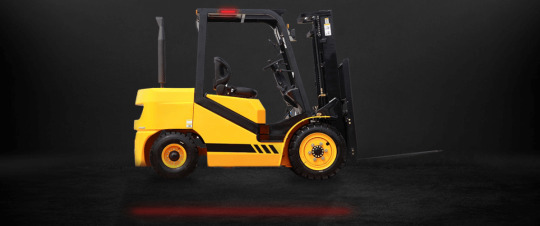
3. Forklift Laser Light
Forklift laser lights represent a cutting-edge safety feature found in certain forklift models. These lights project a visible laser line or pattern onto the floor, aiding in delineating a secure path for the forklift's movement.
The forklift laser safety lights provide a precise visual reference for operators by indicating the exact path the machine's wheels will traverse. This feature facilitates precise forklift positioning, assists in avoiding obstacles, and enhances navigation in confined spaces. Additionally, it reduces the likelihood of accidents by signaling bystanders and other workers about the forklift's intended route.
Every year, forklift accidents lead to the tragic loss of approximately 75 to 100 workers, with an average of around 87 fatalities annually.
Product Features:
Suitable for Class 1,2,3 and 4
Type: Red laser alignment system
Remote control switch
Laser Light/Battery
Power Source rechargeable battery
Full Recharge time 8 Hours
Use time per recharge 50-70 hours
Laser Wavelength 650mm (red)
Laser power 100mw
Laser safety class IIB
Warranty: 1year
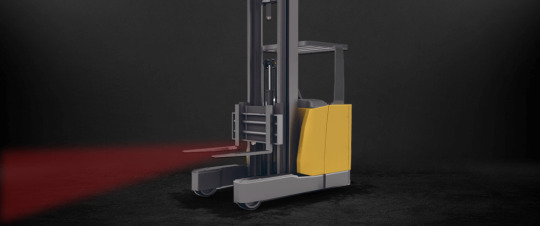
Boost your forklift's visibility and reduce collision risks by 60%. Tap into our 7 unique safety light solutions now!
Reach out to Us
4. Forklift Blue Spot Light
Similar to the forklift arc light, the forklift blue spotlight serves the purpose of creating a visible warning zone around the forklift. It emits blue light, outlining the forklift's perimeter and signalling its presence to others.
The incorporation of forklift blue safety lights contributes to overall safety by clearly delineating the area surrounding the forklift. This innovative feature significantly diminishes the risk of accidents and injuries by alerting workers and pedestrians who might unintentionally enter the forklift's operational zone. These safety lights become especially advantageous in environments with simultaneous operation of multiple forklifts, such as densely packed warehouses or bustling loading docks.
The forklift's spotlight casts a bright beam to alert pedestrians when the forklift manoeuvres through blind intersections or crosses busy aisles. It serves as a proactive warning, enhancing safety and awareness in dynamic work environments.
Product Features:
Casting Aluminum Alloy Housing, the suitable
Design for heating elimination.
Tempered Glass Cover.
High power LED with High quality.
The high performance of 100% waterproof, dustproof & quakeproof.
Double insulated silicon rubberized wire, which can bear very low & high temperatures.
Beam: Projector spot on the ground.
Ingress protection: IP-67
Warranty: 1 Year.
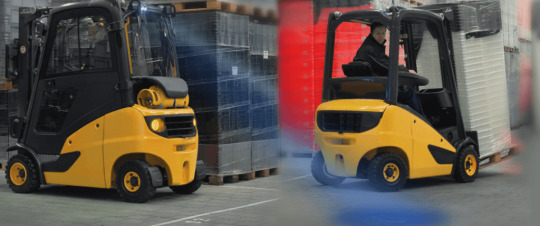
5. Forklift Blue Arrow Light
Forklift blue arrow lights are similar to the forklift blue spotlight but come with an additional feature – they function as LED forklift lights, projecting directional arrows onto the ground to signify the forklift's planned path or direction of movement.
The blue arrow light not only serves as a warning to pedestrians about the forklift's presence but also communicates its intended route. This feature facilitates pedestrians in anticipating the forklift's movements, enabling them to choose optimal spots for walking or standing. This is particularly beneficial in scenarios where forklifts frequently change directions or execute turns.
Product Features:
Casting Aluminum Alloy Housing, the suitable
Design for heating elimination.
Tempered Glass Cover.
High power LED with High quality.
The high performance of 100% waterproof, dustproof & quakeproof.
Double insulated silicon rubberized wire, which can bear very low & high temperatures.
Beam: Projector spot on the ground.
Ingress protection: IP-67
Warranty: 1 Year.

6. Forklift Warning Light
The forklift beacon light, also known as a strobe light or warning beacon, is a highly visible flashing light affixed to the forklift's roof or other conspicuous locations.
Functioning as a strobe light, the forklift warning light emits a bright, flashing signal from the forklift's roof or another prominent location.
Product Features:
Casting Aluminum Alloy Housing, the suitable design for heating elimination.
Tempered Glass Cover.
High power LED with High quality.
The high performance of 100% waterproof, dustproof & quakeproof.
Ingress protection: IP - 65
Warranty: 2 years.
Light source: High - power Osram LED 5pcs*1w
Operating Voltage: 10 - 110V DC
Colour: Amber, Red, Green, Blue & Purple
Pattern: Rotating, Flashing (Once, Twice), Solid (No Pattern)
Material: aluminium die - cast housing, Hard glass cover, stainless steel bracket
Working environment: - 40° - 80°
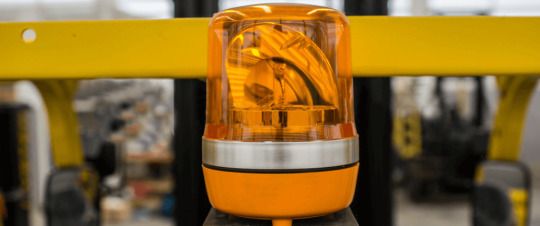
Elevate your forklift operations with lights that cut down hazard rates by half. Unveil the power of our safety lights today!
Talk to our Expert
7. Overhead Crane Light
While not limited to forklifts, facilities utilising both forklifts and overhead cranes employ overhead crane lights. These lights project a distinct, visible signal onto the ground, indicating the position of the overhead crane's load.
In facilities housing both types of machinery, overhead crane lights play a vital role in ensuring security. These lights aid forklift operators and other workers in accurately determining the position of the overhead crane's load, contributing to the safety and avoidance of potential hazards. This preventive measure helps mitigate accidents and collisions between forklifts and overhead crane loads.
Product Features:
Power: 72 Watts
Current: 2.3A @24V Blue, 1.4A @24V RED
Voltage: 9-48 Volts DC
Lumens: 12,000 lumens(each light creates one line)
LEDs: 24
LED colour: Blue Or Red
Beam Type: Line Beam or Spot Light
Working life: Up to 50,000 hours
Size: 9” X 3.9” X 8.6” (228 X 98 X 220mm)
Waterproof: IP67
Working temperature: -40~85°C
Material: Aluminum die-cast housing.
Adjustable mounting bracket: 150 degree up/down.
Cable Length: 0.6 metres.
One year warranty
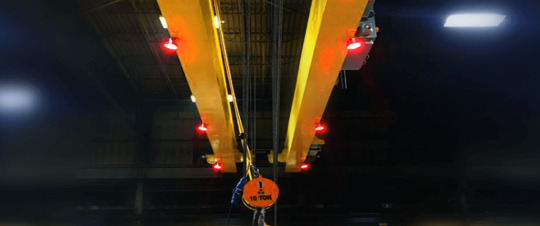
Importance of Forklift Safety Lights
The key motive of Forklift safety lights is to alert pedestrians and other forklift operators about the presence of the forklift in their vicinity and enlarge the warning area. The lights prevent rear-end collisions and foot injuries by making a noticeable boundary around the forklift. The sturdy design of these safety lights can also withstand vibrations and shocks as forklifts are devoid of any conventional suspension setup.
Besides, as the forklifts fetch and transport heavy loads, carrying such an enormous weight, especially on the slopes, can be challenging without any safety accessories. Forklift lights, when combined with speed limiter and forklift camera systems, can further enhance safety and allow easy negotiations on the slopes, preventing a potential collision. With efficient illumination, these lights create trails for the docking forklift trucks by projecting outlines, and safety signage in and out.
The importance of forklift safety lights goes well beyond this paragraph, and for more info — check this guide!
Choose SharpEagle and turn your forklift into a mobile warning system
Forklift lights serve as a critical enhancement in warehouses, significantly boosting safety levels and minimising the risk of injuries and fatalities. These lights form an essential part of the pedestrian warning system for forklifts, alerting workers who may be engrossed in paperwork, conversations on mobile phones, or moving from aisle to aisle, thereby ensuring they are aware of and can steer clear of an approaching forklift.
The pedestrian warning system for forklifts, with its array of specialised lights, plays a pivotal role in ensuring utmost safety during forklift operations. In addition to standard headlights, taillights, and brake lights, other crucial lights such as red, blue, arc, laser, and various warning lights significantly enhance the forklift's safety features. SharpEagle, a leader in safety product innovation, offers a diverse range of safety lights. Contact our expert team today for competitive pricing quotes, and benefit from our comprehensive services including the installation and maintenance of forklift safety lights.
The Final Thought
Both forklift operators and employees must comprehend the purposes of these forklift safety lights. To make the workplace safer and lower the risk of accidents and injuries, proper training and awareness campaigns can be implemented. As technology advances, We can expect to see even more comprehensive safety features added to forklift technology in order to further improve workplace safety in industries that depend on these necessary vehicles.
Let our team help you with the right choice for your workplace safety. We are just a click away!
Get Free Expert Consultation
You can also call us at +971-45549547 or mail us at [email protected]
#Forklift Arc Light#forklift blue light#forklift blue safety lights#forklift light#forklift red zone light#forklift safety laser light#forklift safety light#overhead crane warning lights#Forklift safety lights#blue spot light for forklifts#forklift safety lights red#blue forklift safety light
0 notes
Text
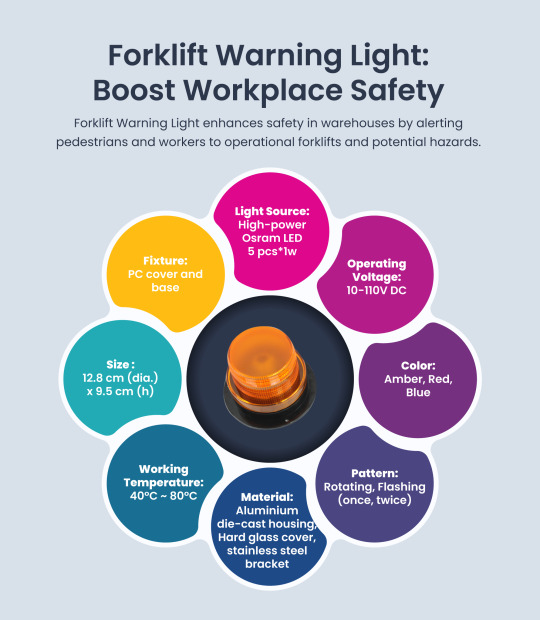
Forklift Warning Light- Boost Workplace Safety
Forklift warning lights are essential safety tools that enhance workplace visibility, prevent accidents, and improve operational efficiency by projecting bright beams to alert pedestrians of approaching forklifts, marking safe zones, and reducing collision risks in busy or dimly lit environments.
#fork truck warning lights#warning light for forklift#overhead crane warning light#forklift beacon light#osha overhead crane warning lights#side-mounted Forklift warning light
0 notes
Text
Crane Accident Prevention & OSHA Regulations Guide

Between 2011 and 2017, the Census of Fatal Occupational Injuries (CFOI) reported a staggering total of 297 crane-related deaths. Mishaps caused by lapses in crane safety often put the lives of the crew members at risk and result in significant losses for the company. Imagine the impact of a crane malfunction on a bustling construction site or industrial setting. In such scenarios, crane lights can make all the difference. Making sure that crane safety lights work efficiently isn't a choice - it's a mandate to stop accidents and follow strict OSHA rules.
This blog explores the key role of crane safety lights in protecting workers and meeting OSHA standards. We��'ll look at the main causes of crane accidents and examine legal impacts and OSHA safety guidelines. Our aim is to shed light on the proactive safety measures in high-risk settings. By using safety lights properly, companies ensure compliance and create a secure work environment.
Want to discover how adding safety lights prevents crane accidents and boosts workplace safety? Read on to understand the crucial role of crane safety lights in accident prevention and regulatory compliance.
Introduction to Crane Accident Injuries and OSHA Safety Regulations
Construction sites have huge cranes operating, where these machines lift heavy objects on a daily basis. Their malfunctioning could cause terrible accidents, including workers getting injured or even dying. This is why companies are in a continuous pursuit for creating optimal working conditions and preventing these accidents. When you think about how crane mishaps also bring lawsuits and fines, these problems cost a ton too!
Crane accidents happen for different reasons. They occur mostly when operators and crew don't communicate well, or when safety rules aren't followed properly. Busy work areas only add to the chaos, and prevent proper communication.
That's why OSHA has made strict crane safety rules, which exist to train operators correctly. Ignoring OSHA guidelines can bring about harsh penalties, lawsuits and reputation hits for the companies. At the minimum, safety gear must be worn and general precautions should be taken to comply with the set safety standards.
Putting crane safety first lowers accident risk, by enabling clear communication when voice or clear line of sight are difficult to achieve.
By investing in training, safety equipment, and implementing OSHA regulations, you can create a safer working environment, reduce accidents, and protect the well-being of the workers.
Why Do Crane Accidents Happen
Crane mishaps can lead to grave injuries, property wreckage, and even deaths. Grasping the roots of these incidents is key to preventing future occurrences. Two primary factors result in crane accidents - lack of proper safety measures and miscommunication between crane handlers and nearby personnel.
Lack of Proper Safety Procedures
Crane mishaps often happen due to the absence or inadequate implementation of safety protocols. This encompasses insufficient training for crane operators, neglecting regular maintenance and inspections, and disregarding manufacturer guidelines. Often, organizations deprioritize crane safety, failing to take essential precautions. Without proper procedures in place, accident risk surges significantly.
Miscommunication Between Operators and Surrounding Personnel
Effective communication is crucial for crane operations. Miscommunication can trigger disastrous results. Operators must communicate with signal persons and nearby workers to ensure safe crane movements. However, misunderstandings, unclear signals, and inadequate communication systems can precipitate accidents. Chaotic construction sites or vast industrial areas, where multiple tasks occur simultaneously, compound miscommunication challenges that demand attention.
Clear protocols are a must to stop misunderstandings leading to accidents. Ensuring proper visibility is key. Using radios and headsets to communicate on the worksite can help too.
Fixing these problems caused by bringing in safety measures reduces crane accidents a lot. The next part talks about legal problems crane accidents can cause. Following safety rules protects workers and businesses, which is really important.
Potential Legal Implications of Crane Accidents
Crane mishaps carry severe legal consequences - for both the companies and individuals. Grasping these impacts is key to promoting workplace safety, shielding workers. Several potential legal ramifications stem from crane accidents:
1. Claims for Personal Harm
Injured individuals may file claims seeking compensation for medical costs, pain/suffering damages, and lost income. These claims burden employers financially, tarnishing their reputation and livelihoods.
2. Workers' Compensation Benefits
When accidents cause injuries/deaths, affected employees receive benefits. Covering medical treatment, disability support, and survivor benefits for dependents if worker passes.
3. Potential Lawsuits
If negligence/defective equipment caused an accident, injured parties/families may sue the responsible party. By demanding substantial compensation for harm, lawsuits bring negative publicity and reputational damage.
Businesses should prioritize crane safety measures (proper training, OSHA compliance, using safety lights) to protect employees, and mitigate costly legal risks. Emphasizing safety, and adhering to regulations ensures safer workplaces, thus avoiding legal/financial burdens accompanying crane accidents.
OSHA Crane Safety Regulations
The Occupational Safety and Health Administration (OSHA) sets key rules for crane safety at work. These guidelines aim to keep workers secure and avoid accidents. Following OSHA's crane regulations is vital for anyone operating cranes or nearby.
Training Requirements
A major part of OSHA's crane safety rules involves thorough operator training. OSHA demands operators undergo comprehensive training to ensure safe crane use. This training covers:
- Operating cranes and controls
- Load limits and capacities
- Inspecting and maintaining cranes
- Proper rigging procedures
- Safe working distances
- Emergency procedures
Employers must provide this training and ensure operator certification meets OSHA standards. Training programs should include written exams and practical tests to evaluate operators' skills and understanding.
Documentation
Apart from training, OSHA emphasizes proper documentation. Employers must keep records of operator certifications, training courses taken, and operator performance evaluations. This documentation proves compliance and ensures adequate training.
Safety Rules
OSHA provides clear crane safety rules. Here are the key guidelines:
The OSHA 1910.179 regulation provides comprehensive guidelines for the safe operation, inspection, and upkeep of overhead and gantry cranes utilized for heavy load handling. Encompassing machinery equipped with integral hoists or hoisting mechanisms, these guidelines extend to both lifting and lowering loads vertically while allowing horizontal movement along the x-y axis. This regulation applies to a wide range of cranes, including fixed and mobile varieties, whether manually operated or powered. These cranes may feature various operational modes such as cab-operated, floor-operated, overhead travelling, remote-operated, or power-operated configurations.
It’s important for managers to note that:
Communication is essential. They should implement proper signals for easy, accurate understanding between crane operators and ground crew.
Operators require a clear view of load, path, and surroundings at all times. Thus, it’s important to address any obstructions that block visibility.
Inspections and crane maintenance are mandatory. Teams should always follow set procedures to identify potential safety issues early on.
Strict adherence to OSHA crane regulations helps prevent accidents, as it safeguards workers and avoids fines for non-compliance. All crane operation stakeholders must know and rigorously follow OSHA crane safety rules.
Crane Accident Prevention
Avoiding crane mishaps is crucial for workplace safety and worker well-being. Implementing practical strategies and following OSHA rules can significantly reduce accident risk. Important for crane safety are safety lights, providing extra visibility and communication to prevent potential incidents.
Here are effective tips and strategies for preventing crane accidents:
1. Proper Training and Certification
Prioritizing proper training and certification for all crane operators is a must, ensuring competence and safety standard adherence. Thorough reputable organization training programs should cover technical skills and emphasize safety protocols.
Regular skill evaluations and updates are key to maintaining operators' proficiency and continued guideline compliance. Investing in comprehensive training and ongoing skill development upholds the highest operation safety and proficiency standards.
2. Follow OSHA Guidelines and Regulations
To maintain a safe work environment, closely adhering to OSHA's crane safety regulations is crucial. This involves understanding and implementing communication protocols, adhering to load limits, and conducting routine inspections per OSHA standards.
Advancing safety standards at your firm is vital, and following OSHA rules fosters a secure workplace. Regular audits identify risks and uphold high safety protocols. This helps achieve the ultimate goal of these protocols at workplaces: protecting the crane staff.
3. Use Safety Lights
SharpEagle's lights boost job site visibility for crane crews. Made for crane safety, these robust lights provide prime line-of-sight, aiding operators and ground teams for flawless operations. That’s why we urge companies to invest in safety lights to raise worksite safety standards, prioritizing the staff’s safety at all times.
4. Practice Effective Communication
Seamless crane operations depend on clear team communication. Establish channels between crane operators and ground personnel for smoother workflows. Use hand signals, radios, and devices - whatever aids precise information transfer. Prioritizing open communication bolsters safety steps and boosts jobsite efficiency.
Consistently maintaining equipment is vital. It ensures cranes operate both safely and efficiently. Regular inspections, repairs, and preventive steps keep cranes in excellent condition.
Detailed records of each maintenance activity prove compliance during site checks. It's crucial for further inspections and audits, as it enables your crane to perform reliably for many years.
Following preventive measures significantly reduces crane accident risks. It creates a safer workplace for all involved individuals. Crane safety isn't merely a legal requirement. It's a moral obligation, to protect workers' well-being. It prevents potential financial and legal consequences too.
Conclusion
Crane safety lights must never be overlooked. They prevent bad accidents and ensure you're following OSHA rules. With crane safety lights, machines on construction sites are easier to see and they communicate more effectively. Everyone knows what is happening, and overall communication gets better on busy work areas. This lowers the chances of accidents.
Having crane safety lights is hardly sufficient without quality assurance. SharpEagle Safety Lights are meticulously designed to ensure optimal safety and efficiency in industrial settings. Crafted with precision and engineered for reliability, our 72W Crane Light stands as a beacon of safety, illuminating the workspace with unparalleled clarity and precision.
Constructed with a robust aluminium body, these lights are built to withstand the rigours of industrial environments, offering durability and longevity. The adjustable mounting bracket, with a flexible range of 150 degrees up and down, allows for seamless installation and precise positioning, ensuring optimal visibility from any angle.
Key Features:
Emitting a powerful 72 Watts, these lights provide ample illumination for overhead crane operations.
Each light produces an impressive 12,000 lumens, casting a bright and clear beam to effectively delineate the working area.
Equipped with 24 high-intensity LEDs, these lights deliver consistent and reliable performance. Choose between striking Blue or Red LEDs, catering to different visibility requirements and preferences.
Opt for either a Line Beam or Spot Light configuration, providing flexibility to suit specific application needs.
With a remarkable lifespan of up to 50,000 hours, these lights offer long-term reliability and peace of mind.
Rated IP67, these lights are fully waterproof, ensuring performance even in the most challenging environments.
Capable of operating in extreme temperatures ranging from -40°C to 85°C, these lights thrive in harsh conditions.
Constructed with an aluminium die-cast housing, these lights prioritize durability and resilience.
Collaborate with SharpEagle, the leading partner in safety solutions to optimize your workplace safety standards. Visit our website to explore our complete range of products or connect with our experts for a free consultation call today!
#overhead crane warning lights#overhead crane lights#overhead crane lighting#Overhead Crane Light#LED Crane Safety Lights#overhead crane warning laser#light duty overhead crane#tower crane lighting requirements#overhead crane safety lights#overhead crane safety warning lights#mobile crane warning lights#Crane LED Safety Lighting#overhead crane warning safety light#crane load indicator lights
0 notes
Text
Complying efficiently with OSHA lighting standards for safety
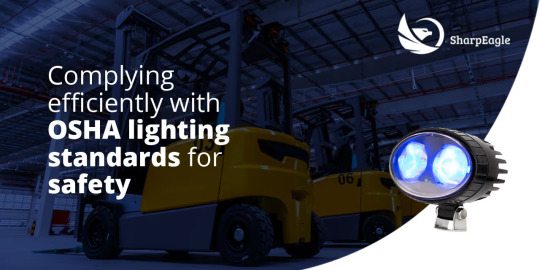
OSHA has established lighting standards for workplaces to ensure adequate lighting is provided for workers to perform their tasks safely and accurately, including LED lights for forklifts. Proper lighting prevents accidents, reduces eye strain, and improves worker productivity. This article will elaborate on a few crucial things to know about OSHA lighting standards for safety in facilities.
OSHA Lighting Safety Requirement
1. General Illumination Requirements
OSHA requires that workplaces be adequately illuminated to ensure that workers can perform their tasks safely and accurately. General illumination must be provided with at least 10-foot candles (FC) for most general areas, with specific exceptions for certain areas such as emergency exit signs and stairways. Foot candles measure the amount of light falling on a surface and can be measured with a light meter.
2. Task Lighting Requirements
In addition to general illumination, OSHA requires task lighting to be provided for areas where workers perform specific tasks that require extra illumination. Task lighting must provide at least 30 fc of illustration and must be directed to minimize glare and shadows. Lamps, overhead fixtures, or portable lights may provide task lighting.
3. Emergency Lighting Requirements
OSHA requires emergency lighting to be provided in case of a power failure or other emergencies. Emergency lighting must provide at least one illumination for at least 90 minutes and must be located in areas where workers may need to navigate to safety in an emergency.
4. Lighting Maintenance Requirements
OSHA requires that lighting fixtures be maintained to ensure that they provide adequate illumination. Burned-out bulbs and other defects must be repaired promptly, and fixtures must be cleaned regularly to remove dirt and dust that can reduce illumination levels.
5. Lighting Design Requirements
OSHA recommends that lighting be designed to minimise glare, shadows, and reflections that can cause eyestrain and visual fatigue. Lighting should be distributed evenly throughout the workplace to prevent dark spots and provide uniform illumination. Lighting should also be shielded to avoid direct exposure to the eyes.
Improve workplace safety and productivity with efficient OSHA-compliant safety lighting. Don’t compromise with safety standards!
Connect with Us
Why Should Your Company Follow OSHA Lighting Requirements?
Several areas can be hazardous to a worker in a work environment, which has specially made LED lights for forklifts important. Lighting becomes a risk factor, especially when the labour is mostly manual and physical. Thus, protection is key, and OSHA lighting requirements are a fundamental protective measure. Some of the important reasons why your company should follow OSHA requirements are:
a) Workplace Safety:
The primary purpose of OSHA lighting standards is to promote workplace safety by ensuring that workplaces are adequately illuminated to prevent accidents and injuries. Proper lighting can help workers to identify and avoid hazards, such as obstacles, spills, and equipment malfunctions.
b) Compliance with Regulations:
Compliance with OSHA lighting standards is mandatory for most workplaces, and failure to comply can result in citations, penalties, and legal liabilities. Employers who comply with OSHA lighting standards can avoid these risks and ensure their workplaces are safe and compliant with regulations.
c) Employee Comfort and Well-being:
Adequate lighting is essential for employee comfort and well-being. Poor lighting can cause eyestrain, headaches, and visual fatigue, decreasing worker productivity and increasing the risk of accidents. Compliance with OSHA lighting standards can promote worker comfort and well-being, increasing job satisfaction and reducing turnover.
d) Improved Productivity:
Proper lighting can improve worker productivity by allowing workers to perform their tasks more accurately and efficiently. Adequate lighting can reduce errors and mistakes, saving time and reducing the need for rework.
e) Cost Savings:
Compliance with OSHA lighting standards can result in cost savings for employers. Adequate lighting can reduce the risk of accidents and injuries, resulting in lower workers' compensation costs and reduced liability insurance premiums. Proper lighting can also reduce energy costs by using more efficient lighting systems.
How Do OSHA Lighting Standards of Safety Protect Workers?
OSHA lighting standards for safety protect workers by ensuring that workplaces are adequately illuminated to prevent accidents and injuries. Here are some of how OSHA lighting standards protect workers:
i) Identification of Hazards:
Adequate workplace lighting helps workers identify and avoid hazards such as obstacles, spills, and equipment malfunctions. Proper lighting can also help workers to identify and respond to emergencies quickly and safely.
ii) Prevention of Accidents and Injuries:
Insufficient lighting can increase the risk of accidents and injuries by making it difficult for workers to see and navigate their surroundings. OSHA lighting standards ensure that workplaces are adequately illuminated to prevent accidents and injuries.
iii) Reduction of Eyestrain and Fatigue:
Insufficient lighting can cause eyestrain, headaches, and visual fatigue, which can decrease worker productivity and increase the risk of accidents, especially in the absence of forklift safety lights. OSHA lighting standards ensure that workplaces are adequately illuminated to reduce these risks and promote worker comfort and well-being.
iv) Compliance with Regulations:
Compliance with OSHA lighting standards is mandatory for most workplaces, and failure to comply can result in citations, penalties, and legal liabilities. Employers who comply with OSHA lighting standards can avoid these risks and ensure their workplaces are safe and compliant with regulations.
In conclusion, proper lighting is essential for workplace safety and productivity. OSHA has established lighting standards to ensure that workplaces provide adequate lighting for workers to perform their tasks safely and accurately. Employers should ensure that their facilities comply with OSHA lighting standards to protect workers and avoid potential OSHA citations and penalties.
How Can Your Company Comply With OSHA Lighting Guidelines With SharpEagle?
Managing and following the OSHA lighting guidelines can be tough and not very profitable, which is one of the major reasons why companies fail to do so. According to reports by ILO, a specialized agency of the UN, low light can cause eye strain and headaches, which reduces productivity and creates more scenarios where someone can get hurt.
SharpEagle understands the gravity and the need for the OSHA lighting guidelines and thus has been successful in creating products that help your company comply with these guidelines. Linear lights, LED lights, work lights, forklift safety lights, and HID lights are our best products that help companies create a safe work environment.
You can also call us at +971-45549547 or mail us at [email protected]
#Forklift Arc Safety Light#Forklift blue safety light#LED Crane Safety Lights#blue safety lights for forklifts#fork truck warning lights#warning light for forklift#overhead crane warning laser#forklift blue light installation#blue spot safety light forklift#overhead crane warning light#light duty overhead crane#red zone danger area warning light#forklift safety lighting
1 note
·
View note
Text
Forklift Safety Lights: You Must Choose but Choose Wisely

The forklift safety lights can bring a massive difference to the operational safety at industries and increase the efficiency of workplaces. These tools have a robust built and are tailor-made to mitigate the odds of forklift accidents and thrust productivity. Any good forklift safety solution provider must extend a complete range of safety tools under one roof to ensure all-round security of its client business, just as UAE’s number safety ranger SharpEagle does. Keep reading today’s blog to know all about forklift safety lights!
➢ Why Is Forklift Safety Light a Must for Your Business?
Forklifts have been a savior for the construction industry. However, it can prove to be a bane instead of a boon if it keeps causing huge losses in a million for the multiple accidents at the workplace. The trouble must end or else your business can never see the face of profit with the increased operational efficiency that forklifts bring. SharpEagle has manufactured and curated well-researched and advanced, premium quality forklift safety solutions to create a safe ecosystem for various industrial sectors globally. The vast range of products includes safety surveillance devices, anti-collision solutions, radar devices, fork view surveillance devices, and many advanced tools to ensure uninterrupted industry activities.
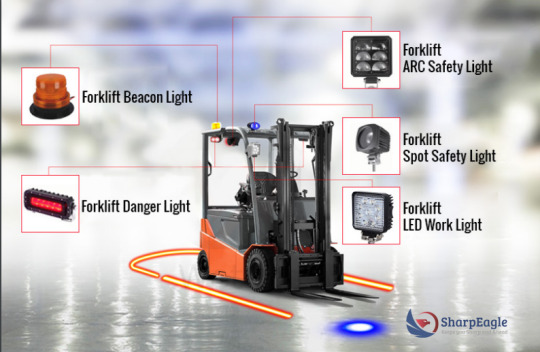
The right tools imply growth in production manifold and create a safe zone for workers and heavy machines even in rugged and combustible factories. Reports show how forklift safety lights have brought down accidents substantially, preventing collision between pedestrians/ operators and forklifts, and have helped promote a secure and healthy work culture, yielding higher profit!
➢ Forklift Safety Lights: Catalogue
Forklifts brought a revolution to many industries but with it came along the deadliest industrial accidents in history. SharpEagle created a vast range of Forklift safety lights to prevent every possibility of injuries and accidents. Their high-tech devices ensure all-round safety at the workplace. These lights have been engineered to provide maximum visibility to the operators and pedestrians. Better visibility not only ensures security but can also double up productivity in a couple of weeks post-installation.
The premium pocket-friendly products by SharpEagle that can give your business the safest ecosystem are:
• Forklift ArcLight:
The arc lights at SharpEagle are manufactured using rubberized wires made of silicon that works well in extreme temperature fluctuations. These devices last long owing to their robust built. The casts are made of an aluminum alloy, and the housing prevents the light from damages or corrosion. The other best feature of the Forklift Arclight is tempered glass which is water, dust, and quakeproof. All devices use high-power LED lights with minimal power consumption.
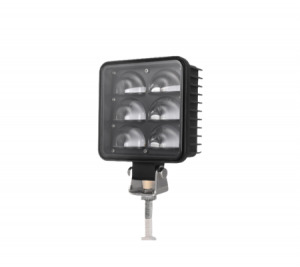
• Forklift Red Danger Light:
SharpEagle’s Forklift Red zone warning lights have red or blue LEDs that can work seamlessly in extreme temperatures ranging from -40 degrees Celsius up to 80 degrees Celsius. Moreover, six bright lights are used in one tool for premium clarity at the time of accidents or danger. The arc lights are 150*60*57 mm in size, and the product comes with a top-notch battery shelf life of around 50000 hours.
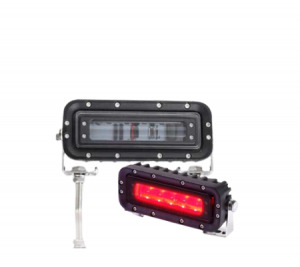
• Forklift Laser Guiding System:
This device comes with a laser beam. This beam works as an indicator of the actual fork position, which helps in multiplying the warehouse security, raising the production level, and minimizing the device damage and transportation time. Forklift laser light is used to ensure safety while lifting heavy materials. SharpEagle has infused remote control facilities and has over 70 hours of life after one recharge. The devices also come with one year warranty.
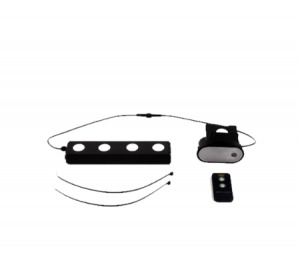
• Forklift Blue Spot Light:
The Forklift blue spotlights are made of an aluminum alloy that makes the casting durable. The LED light comes in a tampered glass box. The emission is blue or red rays. The product has one year warranty. The tool is also waterproof, quakeproof, and has a dustproof caging.

• Forklift Warning Light:
The warning light is engineered to alert the pedestrian or the operator about the impending danger. This device sends an alarm at the possibility of any collision. The equipment comes with a high-power LED chain light and a highly durable tempered glass exterior. This device also has water, dust, and quakeproof casing. The casing is made of aluminum alloy, which helps radiate the excess heat and keeps the device temperature under control. The Forklift warning light at SharpEagle comes with two years warranty.

• Overhead Crane Light:
The cranes are mobile and often threaten pedestrians with high risks of collision. The overhead crane warning lights are a boon in reducing such accidents. The crane light is a 72W LED power with easy adjustment and a mounting facility. The device is extremely easy to install. The body is robust and durable and can work seamlessly in extreme temperature fluctuations.
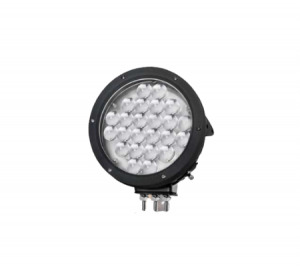
➢ Final Words
SharpEagle has a highly efficient customer support team to help businesses acquire a budget-friendly forklift safety solution. So please share with us the safety light that your business needs the most and get it from UAE’s number 1 safety solution provider at the best price today!
You can also call us at +971-45549547 or mail us at [email protected]
#Forklift Arc Safety Light#Forklift blue safety light#LED Crane Safety Lights#blue safety lights for forklifts#fork truck warning lights#warning light for forklift#overhead crane warning laser#forklift blue light installation#blue spot safety light forklift#overhead crane warning light#light duty overhead crane#red zone danger area warning light#forklift safety lighting#LED Forklift Safety Lights#tower crane lighting requirements#Blue lights for forklifts
1 note
·
View note
Text
Alert Pedestrians Instantly: Blue Spotlight & Red Zone Lights
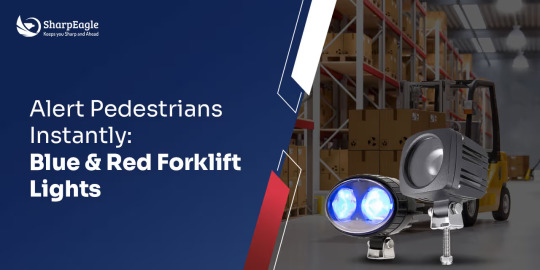
Safety is paramount in industrial environments, especially given the prevalence of forklift trucks, which often pose risks to pedestrians. To address this concern, safety managers are increasingly turning to innovative solutions like Blue Spotlights and Red Zone forklift lights. These LED safety lights serve a crucial role in alerting pedestrians to the presence of forklifts and preventing collisions. The Blue Spotlight projects a distinct blue spot on the ground, while the Red Zone light creates a visible danger zone around the forklift.
Let’s dive into the nuances of both in more detail!
What are Blue Spotlights and Red Zone Forklift lights?
There is a frequent episode that the crew encounters where someone is walking through your factory or warehouse staring at their smartphones or wearing earbuds, unaware of what’s happening around them.
Blue Spotlights and Red Zone forklift lights are essential safety devices designed to enhance visibility and prevent accidents in industrial environments.
The Blue Spotlight projects a prominent blue spot on the ground, serving as a clear indicator of an approaching forklift. It alerts pedestrians to the presence of the forklift, prompting them to adjust their path to avoid potential collisions. By effectively signalling the forklift's location, the Blue Spotlight significantly reduces the risk of pedestrian-forklift accidents.
On the other hand, the Red Zone Forklift Light creates a designated no-go zone around the forklift by projecting two straight red beams onto the ground. This illuminated area serves as a visible danger zone, indicating that the forklift is in motion or actively stacking goods. Pedestrians are thus alerted to keep a safe distance from the vehicle, minimising the risk of accidents caused by inadvertent crossings.
Blue Spotlights
Blue spot lights are a vital safety feature in industrial environments, particularly in warehouses where forklifts are commonly used. These spotlights serve as proactive warning signals for pedestrians, alerting them to the presence of forklifts and helping them avoid potential accidents.
Illuminating the Path for Pedestrians
Mounted on the overhead guard of the forklift, a blue spotlight emits a bright blue spot on the ground, typically extending 10-20 feet in front or behind the forklift. This illuminated path serves as a visual cue for pedestrians, signalling the approach of the forklift and allowing them to adjust their movements accordingly.
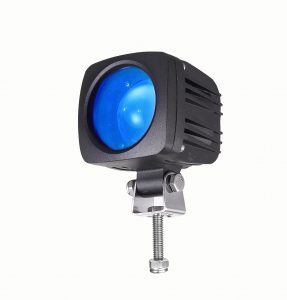
By highlighting the forklift's trajectory, the blue spotlight enhances pedestrian awareness and facilitates safe navigation around the vehicle.
Benefits of Using Blue Spot lights
Enhanced Visibility: Blue spotlights significantly improve visibility in busy industrial settings, especially in areas with low lighting or obscured sightlines. Pedestrians can easily spot the distinctive blue spot, even from a distance, enabling them to steer clear of oncoming forklifts preemptively.
Reduced Accidents: By providing advanced warning of forklift movements, blue spotlights help prevent collisions between pedestrians and forklifts. This proactive safety measure minimises the risk of accidents and injuries in the workplace, fostering a safer environment for all personnel.
Increased Awareness: Blue spotlights raise awareness among pedestrians about potential hazards posed by forklifts, encouraging them to remain vigilant and exercise caution in shared work areas. This heightened awareness promotes a safety-conscious culture and reduces the likelihood of complacency or oversight.
Improved Efficiency: Fewer accidents and disruptions caused by pedestrian-forklift collisions can increase productivity levels as workflow remains uninterrupted. Blue spot lights contribute to the smooth operation of industrial facilities by mitigating safety risks and optimising work processes.
Red Zone Forklift Lights
Red zone forklift lights also known as Red Danger Lights are essential safety devices designed to enhance visibility and prevent accidents in industrial environments, particularly in areas where pedestrians and forklifts interact. These lights serve as proactive warning indicators, delineating a safety perimeter around the forklift to alert pedestrians and other workers of potential hazards.
Overview and Functionality
Mounted on the sides of the forklift's overhead guard, red zone lights project two straight red beams onto the ground, creating a visible safety zone or "no-go zone" around the vehicle. The illuminated area serves as a clear boundary that pedestrians are advised to avoid, signalling the presence of an operational forklift and the potential dangers associated with its movement.
Better Visibility and Safety for Pedestrians
Red zone warning lights significantly improve pedestrian visibility and safety by providing a visual indication of the forklift's operating area and potential hazards. The bright red beams are easily discernible even in busy or dimly lit environments, alerting pedestrians to the forklift's presence and prompting them to maintain a safe distance.
Creating a Visible Safety Zone
The primary function of red zone lights is to create a visible safety zone around the forklift, delineating an area that pedestrians should avoid to minimise the risk of accidents or collisions. By projecting clear red beams onto the ground, these lights define the boundaries of the forklift's operational space, enabling pedestrians to navigate around it safely.
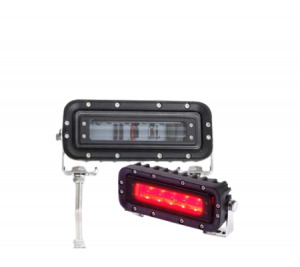
The interesting aspect of the red zone forklift safety light is that the driver does not have to worry about the estimation the pedestrians have to make to keep themselves away from the lift truck. They need to see the danger line, and that’s it.
Benefits of Red Zone Lights
Enhanced Safety: Red zone lights provide a proactive safety measure by clearly defining the forklift's operating area and alerting pedestrians to potential dangers. This helps reduce the risk of accidents and injuries in the workplace.
Improved Awareness: By creating a visible safety zone, red zone lights increase awareness among pedestrians about the presence and movement of forklifts, encouraging them to exercise caution and remain vigilant in shared work areas.
Reduced Collisions: The clear delineation of a safety perimeter around the forklift helps minimise the likelihood of collisions or accidents involving pedestrians. Red zone lights serve as a visual cue for pedestrians to stay clear of the forklift's path, preventing potentially hazardous situations.
Compliance: Implementing red zone lights demonstrates a commitment to workplace safety and regulatory compliance. These lights align with safety standards and guidelines, contributing to a safer work environment and mitigating liability risks.
Read More : Alert Spectators with Forklift Red Danger & Laser Light
Advantages of Blue Spotlight and Red Zone Lights
The key factor is to create a safe working atmosphere around the forklift. The warning lights play an important role in:
• Blind intersections or corners where approaching vehicles or pedestrians can be difficult to spot.
• Reducing the chances of the pedestrians hitting by the rear end swing of a moving or turning forklift truck.
• Providing a safety cover against other speeding forklifts that may collide with the one having loads of goods.
• Enhancing productivity and efficiency, as fewer accidents mean fewer chances of distractions of fellow workers and uninterrupted workflow.
• Making your company compliant with the latest safety standards, also means the betterment of the brand value.
Forklift Safety Lights – A commitment toward a safer and promising business
Blue Spotlights and Red Zone forklift lights are indispensable safety tools that play a vital role in enhancing visibility, reducing accidents, and promoting a safer work environment in industrial settings. By illuminating the path for pedestrians and creating visible safety zones around forklifts, these lights help prevent collisions and minimise the risk of injuries.
At SharpEagle, we understand the importance of workplace safety and are committed to providing high-quality safety solutions to our customers. With years of experience in the industry, SharpEagle has established itself as a trusted provider of forklift safety lights, including Blue Spotlights and Red Zone lights. Our products are designed to meet the highest standards of quality, durability, and performance, ensuring reliable protection for both workers and equipment.
Ensure the safety of your workplace by investing in SharpEagle's forklift safety lights today. Visit our range of products and solutions or contact us directly for personalised assistance.
Let SharpEagle be your partner in creating a safer and more productive work environment.
You can also call us at +971-45549547 or mail us at [email protected]
#Forklift Blue Spot Light#forklift blue safety lights#forklift red zone light#forklift safety lights red#blue forklift safety light#Forklift Red danger light#forklift blue light installation#red zone danger area warning light#Blue lights for forklifts#why do forklifts have blue lights#red zone light for forklift#Forklift Red zone warning light#Forklift Red zone Pedestrian safety warning light#LED Forklift red zone warning light#Forklift red zone danger area warning light
0 notes
Text
The Benefits of Installing Forklift Arc Safety Lights
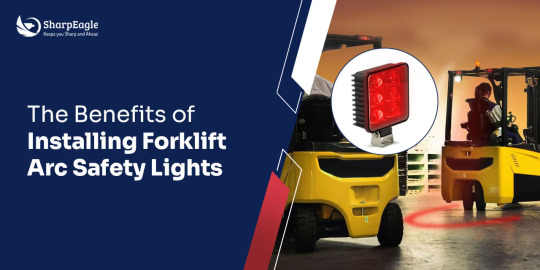
Forklifts are indispensable in warehouses and industrial settings, ensuring efficient handling and transport of goods. However, their heavy use comes with risks. According to the National Safety Council, forklifts cause nearly 85 deaths and 34,900 serious injuries annually in the United States alone. Conventional safety measures, such as operator training, luminous uniforms, and helmets, often prove insufficient in preventing foot injuries and collisions with other machines and pedestrians.
To address these critical safety gaps, innovative solutions like forklift arc safety light have been actively adopted in high-risk worksites. These lights are specifically designed to enhance safety in warehouses, logistics, and distribution centres by providing a clear visual warning of a forklift's presence, significantly reducing the risk of accidents. In this blog, our experts discuss the benefits of installing SharpEagle’s red arc lights on your forklifts and how they can transform your workplace safety.
Red Arc Lights make a drastic difference in warehouse operations
Forklift Arc Safety Lights are a revolutionary safety feature for forklifts, designed to prevent accidents and enhance operational efficiency in warehouses. Unlike conventional safety lights, these forklift halo arc lights create a large, bold arc of light on the ground, signalling danger zones and warning pedestrians and other machinery to keep a safe distance. This proactive approach significantly reduces the risk of collisions and injuries.
SharpEagle's red arc lights project a bright red arc several feet around the vehicle. This clear visual cue ensures that workers are always aware of the forklift’s presence and path. For those who prefer a less aggressive colour in arc lights, SharpEagle also offers blue lights, providing the same level of safety with a different visual impact.
Installing these lights on your forklifts is simple. SharpEagle’s red arc lights can be customised to fit the size of your forklift and the specific safety requirements of your workspace. For larger forklifts, arcs can be installed on all four sides, ensuring comprehensive coverage and maximum safety.
In essence, forklift arc safety lights from SharpEagle offer a simple, cost-effective solution to a serious problem. By implementing these lights, warehouses, logistics, and distribution centres can drastically improve safety and efficiency, creating a safer environment for everyone.
Sturdy Red Arc Lights go a long way
SharpEagle’s arc safety light uses a precision light beam through a specialised projector. These lights are a game-changer for forklift safety, offering a clear visual warning to prevent accidents and enhance operational efficiency. Its IP67 rating makes it waterproof and dustproof, suitable for harsh industrial environments. Furthermore, the light’s sturdy build with aluminium alloy and tempered glass cover as well as its temperature resilience with double-insulated silicon wire offers maximum safety at modern worksites.
Below listed are a wide range of benefits of red arc lights by SharpEagle:
Enhanced Visibility
SharpEagle's red arc lights significantly enhance visibility in low-light conditions, making them ideal for warehouses and industrial environments where lighting is often insufficient. These powerful forklift LED arc beam safety lights project a bold red arc on the ground around the forklift, creating a clear and unmistakable warning zone. This increased visibility helps prevent collisions with other vehicles and pedestrians by alerting them to the forklift’s presence and path. Real-world examples have shown a noticeable decrease in accidents and injuries when forklift arc lights are used. According to safety reports, warehouses that implemented these lights experienced a 30% reduction in collision-related incidents. By improving visibility and providing an effective visual cue, SharpEagle's red arc lights play a crucial role in creating a safer, more efficient working environment.
Worker Safety
SharpEagle's red arc lights are an essential safety feature designed to reduce workplace accidents and injuries. These lights create a prominent red arc around the forklift, alerting workers to its presence and movement. This visual warning system is especially effective in busy warehouses and industrial environments where distractions and noise can cause workers to miss an audio alert of an approaching forklift, thus leading to accidents. By clearly delineating a danger zone, the red arc lights help prevent collisions with pedestrians and other machinery. The enhanced awareness provided by these lights ensures that workers can maintain a safe distance, promoting a safer and more efficient working environment. With SharpEagle's forklift red arc lights, enhancing worker safety becomes a simple and highly effective measure.
Compliance with Safety Regulations
Forklift operation in warehouses and industrial settings is governed by strict safety regulations to protect workers and prevent accidents. Regulatory bodies like OSHA mandate specific lighting and safety measures for forklift operations. SharpEagle's forklift arc lights are designed to help businesses comply with these stringent standards. By providing a clear, visible warning zone around forklifts, these lights meet and often exceed OSHA requirements for visibility and accident prevention. For instance, OSHA regulations emphasise the importance of adequate lighting and warning systems to alert workers to moving machinery. SharpEagle’s red arc lights fulfil these requirements by enhancing visibility and creating a safer working environment. Facilities equipped with these lights not only adhere to safety regulations but also demonstrate a proactive approach to worker safety. This compliance not only reduces the risk of accidents but also helps avoid potential fines and legal issues associated with non-compliance.
Cost-Effectiveness
Investing in SharpEagle's red arc lights is a cost-effective solution for enhancing workplace safety. The initial cost of installing these lights is minimal compared to the significant savings from reduced accidents and injuries. By preventing collisions and ensuring a safer environment, businesses can avoid the high costs associated with workplace injuries, such as medical expenses, workers' compensation, and lost productivity. Additionally, the long-term benefits of improved safety include lower insurance premiums and fewer legal liabilities resulting from workplace accidents. Overall, the cost-effectiveness of SharpEagle's red arc lights extends beyond immediate savings, providing substantial financial benefits in the long run.
Easy Installation and Maintenance
SharpEagle's red arc lights are designed for easy installation on forklifts, making it simple for businesses to enhance their safety measures. The installation process involves securely mounting the lights on the forklift, with clear instructions, expert assistance, and all necessary hardware, allowing for a quick setup without the need for specialised tools.
Maintenance of the red arc lights is minimal, owing to their robust construction and high-quality components. With robust shielding of aluminium alloy and tempered glass cover, the light is designed to withstand harsh industrial environments, offering long-lasting performance with little upkeep. Routine checks and occasional cleaning ensure optimal functionality, while their durability means fewer replacements and lower long-term costs. With an impressive lifespan, SharpEagle’s red arc lights provide reliable safety enhancements, making them a valuable, low-maintenance investment for any warehouse or industrial setting. Read more about Forklift Safety Lights: https://www.sharpeagle.uk/blog/how-to-increase-warehouse-safety-with-forklift-safety-lights
Conclusion
Investing in safety features like SharpEagle's red arc lights is crucial for enhancing workplace efficiency and ensuring employee well-being. By significantly reducing the risk of accidents and injuries, these lights not only protect workers but also contribute to a more productive and compliant operation.
SharpEagle stands as a leading safety and efficiency solutions provider in the GCC and the UK. As end-to-end safety consultants, we offer comprehensive services including site inspections for customised forklift safety and lighting solutions. Our forklift arc safety lights undergo rigorous testing to ensure reliable performance, and we continuously update our models with the latest technological trends to optimise safety standards for your crew, goods, and forklifts. Beyond manufacturing and installation, our team conducts maintenance checks to guarantee ongoing safety in your forklift operations.
Consider enhancing your workplace safety with SharpEagle's red arc lights for forklifts. To learn more about our forklift red zone light, visit our website or book a free consultation call with our experts today!
You can also call us at +971-45549547 or mail us at [email protected]
#Forklift Arc Light#Forklift arc safety lights#Forklift Arc Safety Light#LED forklift arc light#arc safety solutions
0 notes
Text
Top 6 Benefits of Forklift LED Warning Lights
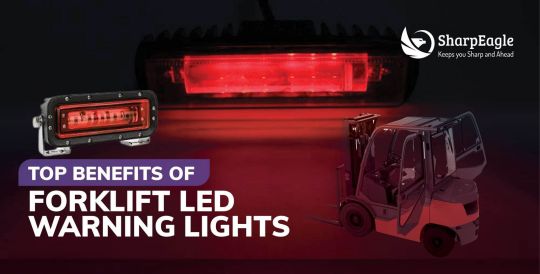
The invention of forklifts has shed the industrial workload of carrying and transporting heavy goods right to a great extent. Today, transporting goods for a shorter distance no longer remains an issue. However, at places where heavy machinery is used, proper safety precautions have to be taken, to ensure everything goes well, without compromising on work efficiency. Typically, the warehouses are activity-filled with lots of movement of forklifts and pedestrians.
According to Occupational Safety and Health Administration (OSHA), pedestrians in warehouses account for about 40 percent of overall accidents. Though all this movement occurs for the common goal of achieving productivity and efficiency, accidents in these high-paced environments can happen in a blink of an eye. So, for ensuring proper safety, Forklift LED warning lights can be used to force pedestrians to keep a safe distance during work activities. Here we will learn about the top benefits of forklift warning lights.
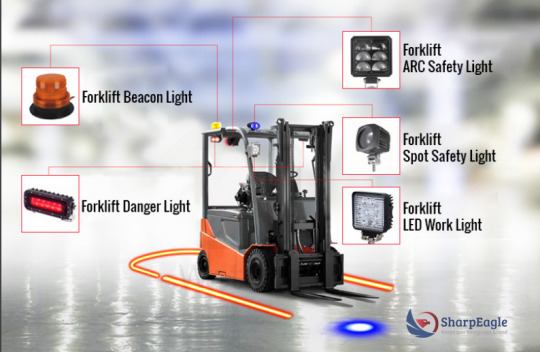
Read More : 5 salient features of fork view camera system
➢ Top reasons to have forklift LED warning lights
It's of utmost importance to warn pedestrians of the oncoming forklift to avoid collisions and fatalities. Warning lights ensure excellent levels of effectiveness in the warehouses. Let’s know how these forklift safety lights can ensure the safety of the employees.
1. Rugged design that guarantees durability
Given the conditions in various industries, the safety lights have to be robust enough to sustain the working environments. The encasing of such forklift safety lights is prepared using a durable tempered glass cover, with a stainless-steel bracket, and aluminum alloy casting for dissipating heat. The body is 100 percent water, dust and quakeproof with an IP 65 protection level. These warning lights can also be customized in different colors, and various rotating and flashing patterns. And with high-powered LEDs inside, the long-term service and low energy consumption can eventually save you money on maintenance costs.
2. Helps boost productivity and efficiency
It is a no-brainer that whenever events of collision or accidents occur in the working premises, the colleagues will rush to check the incident or merely watch as a spectator. These incidents hamper overall productivity and decrease work efficiency. If warning lights are there in the first place, accidents won’t happen and the focus of workers will be entirely on their tasks. The warning lights help keep the pedestrians away by alerting them well in advance of the presence of the forklift in their vicinity.
3. Helps avoid possible lawsuits and adverse effects on the brand
When forklift-related accidents happen in the warehouse, you won’t be delighted to see your worker in agony. And even if you take care of their hospital bills, some workers might not be able to work after serious injuries. They might file a lawsuit against you, which can be a distasteful experience. You would need to hire a lawyer to represent your case in court, and still, it cannot be guaranteed, that you will not lose the case and end up recompensing a hefty amount to the worker. Contrary to this, having forklift warning lights in place can let you avoid a lawsuit, a time-consuming inspection process, as well as, spoiling the brand image.
Longevity You Can Trust! With 90% energy efficiency, our Forklift LED warning lights are your sustainable choice.
Reach out to Us
4. Increases Visibility and forms a safe surrounding
The safety warning lights feature high-powered LEDs, making it easier even for the distant workers to spot the oncoming forklift and keep a safe distance. These lights help form a safe and visible border around it as forklifts are large and heavy machinery carrying loads of goods. It is especially beneficial in and around construction sites where there are a lot of workers around. The warning lights hold the attention of the people around it instantly.
5. Prevents damage of goods
The cost of human life is invaluable, but at the same time, the damage to properties will also set you back right to some extent, especially when it comes to net-worth investments. Moreover, a collision between the forklifts would also cost you extra bucks on repairing. So, warning lights can prevent the loss of goods and costly repairs.
6. Helps you comply with the law
There are rules and regulations set by the governing or regulatory bodies to help keep a safe working atmosphere, not to punish anybody. We must always see things from a positive perspective as to how they can benefit us. Installing forklift safety lights would ensure zero chances of quarrels with the governing authorities. Such incidences can save you from high penalties and improve your brand image. Hence, warning lights can help you comply with the existing laws.
➢ Conclusion
In summary, a typical working day in a warehouse involves plenty of activities, and busy workers can get lost in this hustle and bustle. Forklift safety light is an ideal and most practical solution to avoid potential accidents. SharpEagle, with its range of forklift safety lights, helps you override all these problems and create a safe working atmosphere. Get in touch with SharpEagle, and our experienced team of experts will look after your needs.
You can also call us at +971-45549547 or mail us at [email protected]
#beacon light#forklift safety warning lights#Forklift warning lights#fork truck warning lights#warning light for forklift#overhead crane warning light#forklift beacon light#osha overhead crane warning lights#side-mounted Forklift warning light
0 notes
Text
Application of Blue LEDs in Forklift Safety

Introduction to Blue LEDs and Forklift Safety
Forklifts are an essential tool in many workplaces, but they can also pose a serious safety risk to workers. The Occupational Safety and Health Administration (OSHA) reports that forklifts are responsible for approximately 100,000 workplace accidents every year, including over 90 fatalities. To mitigate this risk, companies are turning to new technologies to increase forklift safety.
Forklift Blue LED lights are a relatively new innovation that has quickly become popular in a variety of applications. These lights are much brighter and more energy efficient than traditional lighting options, making them ideal for use in a range of industries, including the construction, transportation, and warehousing sectors. In particular, these lights have proven to be an effective tool for improving forklift safety.
The primary benefit of using safety lights in forklift is their ability to increase visibility. Forklifts are often used in environments where lighting is poor, such as in dimly lit warehouses or outdoor construction sites. This can make it very difficult for workers to see the forklifts and avoid accidents. By installing the safety lights on forklifts, however, workers can quickly and easily spot them, even in low-light conditions.
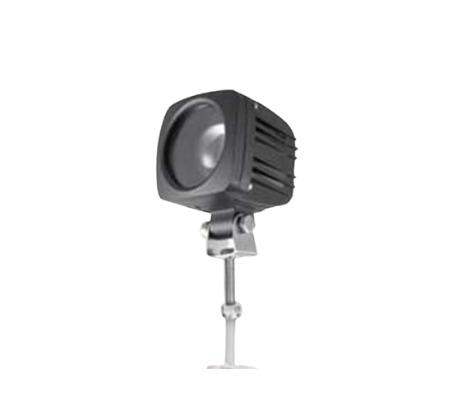
Another benefit of such lights is their ability to alert workers to the presence of a forklift. Forklifts are often quiet, and workers may not hear them approaching. However, by installing safety lights on forklifts, workers can quickly and easily see when a forklift is nearby and take appropriate precautions.
Lastly, lights can also help to prevent accidents caused by distracted driving. Many forklift accidents occur when drivers are distracted, such as when they are talking on the phone or listening to music.
The use of lights is an innovative and effective way to improve forklift safety. By increasing visibility, alerting workers to the presence of forklifts, and reminding drivers to stay focused,these lights can help to reduce the risk of accidents manifold and injuries in the workplace. As such, companies should consider implementing this technology as part of their forklift safety programs.
Benefits of Using Safety Lights in Forklift
The use of Forklift safety lights in forklifts has become increasingly popular in recent years as more and more companies recognize the benefits of this innovative technology. Here are just a few of the key benefits of using safety lights in forklifts:
1. Increased visibility:
One of the most significant benefits of using safety lights in forklifts is the increased visibility they provide. Traditional forklift lighting options, such as headlights and tail lights, may not be sufficient in low-light conditions, such as in dimly lit warehouses or outdoor construction sites. Safety lights, however, are much brighter than traditional lighting options, making them much easier to see, even in poor lighting conditions.
2. Reduced accidents:
Another major benefit of using safety lights for forklift safety is the reduced risk of accidents. By increasing visibility, workers are more likely to see forklifts and take appropriate precautions to avoid accidents. Additionally, the bright blue light is highly visible, making it easier for workers to spot forklifts from a distance.
3. Improved productivity:
The use of forklift safety lights in forklifts can also lead to improved productivity. When workers are confident in their safety, they are more likely to be efficient and productive on the job. Additionally, the increased visibility provided by LED lights can help workers move products more quickly and safely, reducing the risk of delays and accidents.
4. Cost-effective:
Finally, forklift safety lights are a cost-effective option for improving forklift safety. LED lights are much more energy-efficient than traditional lighting options, which can help reduce energy costs over time. Additionally, LED lights require less maintenance than traditional lighting options, which can help to reduce maintenance costs and downtime.
The benefits of using safety lights in forklifts are clear. By increasing visibility, reducing accidents, improving productivity, and offering a cost-effective solution, lights are an excellent option for companies looking to improve safety in their workplace. As such, companies should consider implementing this technology as part of their forklift safety programs.
Applications of Blue LEDs in Forklift Safety
Safety lights have numerous applications. Here are some of the prime ways that companies can use lights to improve safety in their workplaces:
A. Forklift-mounted lights:
One of the most common applications of Blue LED lights in forklift safety is to mount them on the forklift itself. This can include headlights, tail lights, and side lights, as well as flashing warning lights. These lights make the forklift more visible to workers, helping to reduce the risk of accidents.
B. Pedestrian safety lights:
Another application of Blue LED lights in forklift safety is to install pedestrian safety lights around the perimeter of a warehouse or construction site. These lights are designed to warn pedestrians when a forklift is approaching, giving them time to move out of the way.
C. Warning lights:
Blue safety lights can also be used as warning lights in high-risk areas. For example, a light may be installed above a doorway to warn workers that forklifts may be passing through.
D. Safety barriers:
In some cases, lights may be used to create safety barriers around high-risk areas, such as loading docks or elevated work platforms. These barriers can help to prevent accidents by clearly marking the boundaries of these areas.
E. Traffic lights:
Finally, the Blue LED lights can be used as traffic lights in busy warehouses or loading docks. By installing safety lights at intersections or other high-traffic areas, companies can help manage traffic flow and also reduce the risk of accidents.
These lights have numerous applications in forklift safety. From forklift-mounted lights to safety barriers and traffic lights, companies can use this innovative technology to improve safety in their workplaces. As such, businesses should consider the various applications of blue LED lights for forklifts when implementing forklift safety programs.
Implementing Forklift Safety Programs in the Workplace
Implementing a forklift safety program in the workplace is an effective way to improve safety and reduce the risk of accidents. Here are some key steps companies can take to implement such a program:
i) Identify high-risk areas:
The first step in implementing a forklift safety program is to identify the areas of the workplace that are most at risk for accidents. This may include areas with high traffic volume, blind spots, or areas with limited visibility.
ii) Choose the appropriate lighting:
Once high-risk areas have been identified, companies should choose the appropriate lighting options for each area. This may include forklift-mounted lights, pedestrian safety lights, warning lights, safety barriers, or traffic lights.
iii) Train employees:
Employees should be properly trained on the use of lights and their role in forklift safety. This may include instruction on how to operate forklift-mounted lights, how to recognize pedestrian safety lights, and how to respond to warning lights or safety barriers.
iv) Monitor effectiveness:
After implementing a forklift safety program, companies should monitor its effectiveness over time. This may include conducting regular safety audits, tracking accident rates, and soliciting feedback from employees.
v) Make adjustments as necessary:
Based on the monitoring process, companies should make adjustments to the program as necessary. This may include adding or removing lighting options, increasing training efforts, or making changes to safety procedures.
By implementing a forklift safety program in the workplace, companies can greatly reduce the risk of accidents and improve overall safety. However, it is important to note that such a program should be part of a larger safety plan that includes regular safety training, equipment maintenance, and safety procedures.
Let the Blue Halo Guide You to Better Yield
The application of Forklift blue LED lights in forklift safety offers a wide range of benefits for businesses.
By mounting the lights on forklifts, installing pedestrian safety lights, using warning lights and safety barriers, and implementing traffic lights, companies can improve safety in the workplace, reduce accidents, and increase productivity.
In addition, they are highly cost-effective, providing energy savings, reduced maintenance costs, and a safer workplace, which can all lead to increased profitability. Therefore, it is very crucial for businesses to consider the use of safety lights in their forklift safety light programs.
SharpEagle is a leading provider of innovative safety solutions, including blue LED lights for forklifts. With a focus on safety, efficiency, and productivity, SharpEagle offers a range of high-quality safety lights that are designed to meet the specific needs of businesses. Their products are rigorously tested and certified, ensuring that they meet the highest standards of safety and quality.
If you're looking for a reliable and effective forklift safety lighting solution, SharpEagle's safety lights are an excellent choice. Contact today to learn more about the products and how they can help improve safety and productivity in your workplace.
You can also call us at +971-45549547 or mail us at [email protected]
#forklift blue safety lights#blue forklift safety light#blue led forklift safety light#forklift blue arrow light#Forklift blue safety light#blue safety lights for forklifts#forklift blue light installation#Blue lights for forklifts#why do forklifts have blue lights
0 notes
Text
Alert Spectators with Forklift Red Danger & Laser Light
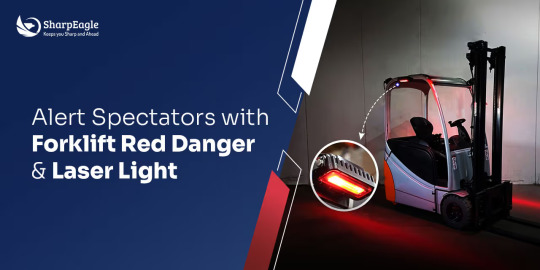
Grabbing the attention of workers and other pedestrians in a buzzing warehouse isn’t an easy task. With just a little time to react, you need a reliable and sturdy lighting solution. And this is where SharpEagle’s Forklift lighting solutions come into play.
When the phrase “forklift safety” comes to mind, one of the first things that usually springs to people's minds is how easily serious and potentially fatal accidents can happen. To help warehouse managers and business owners ensure that their employees stay safe when operating machinery such as forklifts, it is important to utilise all available methods for controlling potential hazards and communicating warning messages quickly.
One effective way of doing this is using Red Danger Zone Warning lights or Laser Lights on a forklift to grab onlookers' attention in an instant.
Today, we’re going to look at the Red Danger Light and Laser Lights, which are the most effective ways to signal a safe distance and catch the spectators' attention!
The Significance of Forklift Safety
Forklift operation within bustling warehouse environments presents inherent hazards and risks that require meticulous attention and proactive safety measures. Let's explore the critical significance of forklift safety and the imperative need for robust safety protocols:
Potential Hazards and Risks
Operating forklifts in busy warehouse settings entails navigating through narrow aisles, congested pathways, and around stacked inventory—all of which pose potential hazards to both operators and pedestrians. The combination of limited visibility, heavy loads, and fast-paced operations increases the risk of collisions, falls, and material handling accidents. Not to mention the presence of varying floor conditions, such as uneven surfaces or spills, further amplifies the danger associated with forklift operation.
Without adequate safety measures in place, these hazards can lead to serious injuries, fatalities, and costly property damage. Read more: Forklift Safety Solutions - Tips To Avoid Injuries
Importance of Implementing Robust Safety Measures
Given the gravity of the risks involved, it is paramount for warehouse managers and business owners to prioritise the implementation of robust safety measures to mitigate accidents and injuries. This includes investing in advanced safety technologies such as forklift red danger lights and laser lights, which serve as proactive warning systems to alert both operators and pedestrians of potential dangers in real-time.
By incorporating these lighting solutions into forklift operations, businesses can enhance visibility, establish clear safety zones, and minimise the likelihood of accidents occurring.
On top of that, comprehensive safety protocols should encompass rigorous training programs for forklift operators, emphasising safe operating practices, load handling techniques, and awareness of surrounding hazards. Regular maintenance and inspection of forklifts are also essential to ensure optimal performance and identify any potential mechanical issues that could compromise safety.
Want to read more about safety measures? This guide has all the answers.
Red Danger Lights and Forklift Lasers — The Perfect Safety Combo
Forklift Red Danger Lights and Forklift Laser Lights on forklifts have quickly become an industry standard for safety. Danger lights typically feature a bright, flashing red light that illuminates the area to draw immediate attention in a moment of emergency.
With laser lights, you can project lines onto walls, floors, or any other surface to mark out designated paths, while installing red danger lights and laser lights on a forklift can be a great way to quickly grab attention, especially when in tight spaces with limited visibility.
These are powered by their own independent energy sources, making them ideal for mobile machinery. In combination with red lights, you can also implement blue safety lights. If you want to know more, this guide is the one to read.
But, let’s get into more specifics of these lights and what makes them a great safety option!
Understanding Red Danger Light
Red is considered a symbol of danger and will easily catch the attention of walkers who’ll instantly keep safe from an impending collision. What is great with our red danger Warning lights is that they emit a line of red lights on the sides of the vehicle, marking the safety zone that pedestrians shouldn’t cross!
Key Features
Red lights by SharpEagle are a perfect way to keep pedestrians safe from collisions or getting their feet injured. This system comes with LED lights of the highest power and aluminium housing for the lights’ safety. Double-insulated rubber wire ensures that the electricity supply is uninterruptedly flowing to the lights.
Our Forklift Red Danger Zone Warning Lights:
Have 6 pieces of 18W Osram LED lights
Operating voltage range of 10-80V
Double-insulated silicon rubberized wire able to bear high temperatures
Aluminum Die-Cast Housing
Stainless Steel Bracket Cover
1-year Warranty
Laser Light
The laser light beams help bring attention to the pedestrians by emitting strong laser light in their direction, boosting their focus and helping them get more alert. This light also has the function of establishing fork proximity for faster and easier transport and loading and unloading of goods!
youtube
Key Features
This system indicates the exact position of the fork, increasing productivity and reducing transportation time and chances of damage to the product. The light source is a rechargeable battery that’s remotely controlled and has a laser wavelength of 100mW and 650mm!
SharpEagle’s Foklift Laser Lights:
Are suitable for Class 1,2,3, and 4
Are operated by a remote control switch
Use a rechargeable battery, taking 8 hours to recharge
70 hours of battery lifetime
Laser wavelength of 650mm (red light) and 100mW power, with safety class of IIB
1-year warranty
Laser lights are great attention-grabbers! More on them you can read in this guide.
Added Benefits of Combining Red Danger Lights and Laser Lights
The integration of both Forklift Red Danger Lights and Forklift Laser Lights creates a synergistic safety system that offers comprehensive protection for both operators and pedestrians in warehouse environments.
Enhanced Visibility and Awareness
Red Danger Warning Lights serve as prominent visual indicators, signalling potential hazards and establishing clear safety zones around the forklift. The bright, flashing red light immediately draws attention, alerting nearby personnel to exercise caution and maintain a safe distance. By illuminating the surrounding area with a conspicuous warning signal, Red Danger Safety Lights improve visibility and enhance situational awareness, reducing the risk of accidents and collisions.
Forklift Laser lights, on the other hand, complement the functionality of Red Danger Lights by providing additional visual cues and guidance. By projecting lines onto floors, walls, or other surfaces, laser lights delineate designated pathways and highlight safe areas for pedestrians and operators to navigate. These laser projections serve as proactive reminders of spatial boundaries and potential danger zones, prompting individuals to remain vigilant and adhere to established safety protocols.
Comprehensive Safety System
When used in conjunction, Forklift Red Danger Lights and Forklift Laser lights create a multifaceted safety system that addresses various aspects of forklift operation and pedestrian safety. Red danger lights excel in signalling immediate danger and establishing exclusion zones around the forklift, while Laser Lights contribute to proactive hazard mitigation and spatial awareness.
For example, in scenarios where a forklift is manoeuvring through congested aisles or tight spaces, red danger lights illuminate the immediate surroundings, alerting pedestrians to maintain a safe distance and avoid potential collisions. Simultaneously, laser lights project clear lines on the floor, guiding pedestrians along designated pathways and highlighting safe areas for passage. This dual approach ensures comprehensive coverage and maximises visibility, minimising the risk of accidents and injuries.
With these tips in mind, you can confidently and safely use your forklift!
Conclusion
Forklift safety lights come as an added bonus in your business that mitigates risks of injuries and fatalities. SharpEagle is a leading end-to-end safety consultant in the GCC and UK. Our experts assist you with the best lighting solutions for your forklift operating needs, so that you can invest in a high-quality option for your safety protocols.
Visit our website to know more about Forklift Red Danger Lights and Laser Lights. Connect with our experts today for customised forklift safety lighting solutions.
You can also call us at +971-45549547 or mail us at [email protected]
#forklift laser safety lights#forklift red zone light#forklift safety laser light#forklift safety lights red#Forklift Red danger light#Forklift Laser Light#red zone danger area warning light#red zone light for forklift#forklift indicator lights#Forklift Laser Pedestrian Warning Light#best forklift laser safety lights#Forklift Red zone warning light#Forklift Red zone Pedestrian safety warning light#LED Forklift red zone warning light#Forklift red zone danger area warning light#Youtube
0 notes
Text
Top 5 Forklift Safety Rules You Need to Know in the UK
Forklift safety is paramount in maintaining a secure and efficient workplace, particularly in industries reliant on heavy machinery. In the UK, adhering to updated forklift safety rules is not just a legal obligation but a critical aspect of protecting workers and pedestrians on-site.
This blog aims to inform and guide you on the top five essential forklift safety rules you need to know. By understanding these guidelines, you can enhance forklift pedestrian safety, ensure compliance with safety regulations, and promote a culture of vigilance and responsibility in your workplace. These fundamental rules help you create a safer and more productive environment for the business and its workforce.
The 5 essential safety rules we’re focusing on today include:
Comprehensive Training and Certification
Regular Equipment Inspections and Maintenance
Safe Operating Practices
Proper Use of Safety Gear and Equipment
Implementing Safety Signage and Procedures
Comprehensive Training and Certification
Ensuring that forklift operators receive proper training is crucial for maintaining a safe workplace. Trained operators are less likely to cause accidents, which can lead to serious injuries or even fatalities. Comprehensive training equips operators with the skills and knowledge needed to handle forklifts efficiently and safely, reducing the risk of mishaps and enhancing overall productivity.
Overview of Certification Requirements in the UK
The Health and Safety Executive (HSE) mandates that employers provide adequate training to all forklift operators. This includes basic training, specific job training, and familiarisation with the work environment. Certification is typically issued upon successful completion of a recognized training course, which ensures that operators meet the necessary safety and operational standards.
Updates to Training Protocols in 2024
As of 2024, updated training protocols have been introduced to further enhance forklift safety in the UK. These updates include more rigorous training modules, increased focus on practical skills, and the integration of advanced safety technologies.
These revised protocols aim to address the evolving challenges in forklift operations and ensure that operators are well-prepared to handle modern machinery safely and efficiently.
Benefits of Ongoing Training and Refresher Courses
Ongoing training and refresher courses are vital for maintaining high safety standards. Regular training sessions help operators stay up-to-date with the latest safety practices and technological advancements. Refresher courses reinforce essential skills and knowledge, preventing complacency and ensuring that operators continue to perform their duties safely. Continuous education fosters a culture of safety, reducing the likelihood of accidents and improving overall workplace safety.
If you want to learn more about forklift operator safety programs, here’s a guide for you.
Regular Equipment Inspections and Maintenance
Daily pre-operation checks are essential for ensuring the safe and efficient functioning of forklifts. Before starting any operation, operators should inspect their forklifts to identify potential issues that could compromise safety. These checks help in detecting problems early, preventing breakdowns, accidents, and costly repairs. By addressing issues before they escalate, daily inspections contribute significantly to maintaining a safe work environment.
Detailed Checklist for Forklift Inspections
A comprehensive inspection checklist ensures that no aspect of the forklift's condition is overlooked. Here is a detailed checklist that operators should follow during daily pre-operation checks:
Visual Inspection:
Check for any visible damage or leaks.
Ensure all decals and warning labels are in place and readable.
Verify the condition of the tires, looking for proper inflation and any signs of wear or damage.
Fluid Levels:
Check engine oil, hydraulic fluid, and coolant levels.
Ensure there are no leaks or contamination.
Operational Checks:
Test the brakes, including the parking brake, to ensure they function correctly.
Check the steering for smooth and responsive operation.
Verify that all lights (headlights, taillights, warning lights) and indicators are working.
Ensure that the horn and backup alarm are functional.
Forks and Mast:
Inspect the forks for cracks, bends, or excessive wear.
Check the mast for smooth operation and ensure there are no obstructions or damage.
Safety Devices:
Confirm that seat belts, mirrors, and other safety devices are in good condition and properly adjusted.
Check the load backrest extension for damage or misalignment.
Maintenance Schedule and Documentation
A regular maintenance schedule is crucial for keeping forklifts in optimal condition and ensuring long-term safety and efficiency. Establish a maintenance routine based on the manufacturer's recommendations and the forklift's usage. Typically, this includes:
Daily Checks: Conduct the detailed preoperative inspections as outlined above.
Weekly Maintenance: Inspect and clean air filters, check battery water levels, and ensure all bolts and fasteners are tight.
Monthly Checks: Perform more in-depth inspections of the hydraulic system, tires, and overall forklift structure. Lubricate all moving parts as needed.
Quarterly and Annual Maintenance: Conduct thorough inspections and servicing, including engine tune-ups, replacing worn-out parts, and comprehensive safety checks.
Documentation of all inspections and maintenance activities is vital. This documentation ensures accountability, helps track the forklift's condition over time, and provides valuable information for future maintenance planning.
Safe Operating Practices
Maintaining control over forklift speed is crucial for ensuring safety in the workplace. Operators should strictly adhere to speed limits set for various areas within the facility to minimise the risk of collisions and accidents. Additionally, following designated pathways helps in organising traffic flow, reducing the likelihood of accidents between forklifts and pedestrians. Clearly marked routes and proper signage further enhance safety by guiding operators and alerting pedestrians to forklift activity.
Guidelines for Handling Loads and Operating in Different Environments
Proper load handling is essential for preventing accidents and ensuring stability during forklift operations. Operators should:
Always check the load for stability and secure it properly before moving.
Ensure the load does not exceed the forklift’s capacity.
Keep the load low to the ground and tilted back slightly while moving.
Avoid abrupt movements and sharp turns, especially with a loaded forklift.
Different operating environments require specific considerations. For instance:
In indoor settings, operators should be cautious of narrow aisles, low ceilings, and other obstructions.
Outdoor operations demand attention to uneven surfaces, weather conditions, and potential obstacles like debris.
Adapting driving techniques to suit the environment helps in maintaining control and ensuring safety.
Importance of Visibility and Use of Lights and Signals
Visibility is a key factor in preventing accidents. Operators must ensure they have a clear line of sight and use the forklift’s lights and signals effectively:
Use headlights when operating in dimly lit areas or outdoors during low visibility conditions.
Engage warning lights and alarms to alert nearby workers and pedestrians.
Utilise mirrors to enhance visibility, particularly when reversing or navigating tight spaces.
Communicate intentions using hand signals or the forklift’s horn to alert others of movement.
Ensuring good visibility and effective use of signals can significantly reduce the risk of accidents involving forklifts and pedestrians.
SharpEagle can help you boost visibility and enhance your signals with quality equipment!
Updated Regulations on Safe Operating Practices for 2024
The 2024 updates to forklift safety regulations in the UK emphasise enhanced operational practices to further mitigate risks. Key changes include:
Stricter enforcement of speed limits within workplace environments.
More detailed guidelines on safe load handling, including mandatory training on securing and transporting various types of loads.
Increased emphasis on using advanced safety technologies, such as collision avoidance systems and enhanced lighting.
Regular audits and inspections to ensure compliance with updated safety standards.
Adhering to these updated regulations is essential for maintaining a safe working environment and ensuring compliance with legal requirements.
Proper Use of Safety Gear and Equipment
Mandatory Safety Gear for Forklift Operators
Ensuring that forklift operators wear the appropriate safety gear is crucial for their protection. In the UK, the following safety gear is mandatory for forklift operators:
Helmets: To protect against head injuries from falling objects or collisions.
High-Visibility Clothing: To ensure operators are easily seen by pedestrians and other machinery operators, reducing the risk of accidents.
Safety Shoes: To protect feet from heavy objects and to provide better grip on slippery surfaces.
Gloves: To enhance grip and protect hands from injuries and exposure to harmful substances.
By equipping operators with the right gear, employers can significantly enhance their safety and reduce the likelihood of injury.
Importance of Seat Belts and Other Safety Features
Seat belts are a fundamental safety feature that must be used at all times while operating a forklift. They help keep the operator securely in the seat, preventing ejection in the event of a collision or sudden stop. Other essential safety features include:
Rollover Protection Systems (ROPS): Designed to protect the operator in the event of a rollover.
Backup Alarms: To alert nearby workers when the forklift is reversing.
Mirrors and Cameras: To enhance visibility and reduce blind spots.
Load Backrest Extensions: To prevent loads from falling backward onto the operator.
Ensuring these features are functional and used correctly is crucial for maintaining a safe operating environment.
Encouraging a Culture of Safety Compliance Among Workers
Fostering a culture of safety compliance is essential for ensuring that all safety protocols are followed consistently. This can be achieved by:
Regular Training and Awareness Programs: Educate workers on the importance of using safety gear and following safety procedures.
Clear Communication of Safety Policies: Ensure all workers are aware of the safety policies and the consequences of non-compliance.
Safety Audits and Inspections: Conduct regular audits and inspections to ensure compliance with safety standards.
Encouraging Reporting of Safety Hazards: Create an environment where workers feel comfortable reporting safety concerns without fear of reprisal.
Implementing Safety Signage and Procedures
Clear and visible safety signage is vital in preventing accidents and ensuring a safe work environment. Safety signs communicate important information quickly and effectively, guiding operators and pedestrians in making safe decisions. Proper signage helps in identifying hazards, directing traffic, and providing instructions, thereby reducing the risk of accidents and promoting a culture of safety awareness.
Types of Signs and Their Meanings
Safety signs come in various types, each serving a specific purpose and conveying different messages. Understanding these signs and their meanings is essential for maintaining safety:
Warning Signs: These signs alert workers to potential hazards or dangers, such as "Caution: Forklift Operating Area" or "Danger: High Voltage."
Instructional Signs: Provide specific instructions or procedures that must be followed, such as "Wear Protective Gear" or "Keep Aisles Clear."
Informational Signs: Offer general information or reminders, such as "Emergency Exit" or "First Aid Station."
Prohibition Signs: Indicate actions that are not allowed, such as "No Entry" or "No Smoking."
Each type of sign uses specific colours and symbols to convey its message clearly and effectively. Explore our offer of safety signage here.
Updated Guidelines for Safety Signage Placement and Maintenance
As of 2024, new guidelines for the placement and maintenance of safety signage have been introduced to enhance workplace safety. Key points include:
Placement: Signs should be positioned at eye level and in locations where they are easily visible to operators and pedestrians. They should be placed near potential hazards, entry and exit points, and along designated pathways.
Consistency: Use standardised colours, symbols, and wording to ensure clarity and uniformity across the workplace.
Maintenance: Regularly inspect signs for damage, wear, or fading, and replace them as needed to ensure they remain legible and effective. Ensure that signs are clean and unobstructed at all times.
Adhering to these updated guidelines helps maintain a safe and well-organised workplace.
Procedures for Emergency Situations and Reporting Accidents
Having clear procedures for emergency situations and reporting accidents is crucial for minimising harm and ensuring a swift response. Key procedures include:
Emergency Situations:
Establish clear evacuation routes and ensure they are marked with visible signage.
Provide training on emergency response, including the use of fire extinguishers, first aid, and emergency shutdown procedures.
Conduct regular emergency drills to ensure all employees are familiar with evacuation procedures.
Reporting Accidents:
Implement a straightforward process for reporting accidents and near-misses. Ensure all employees are aware of this process.
Encourage prompt reporting of any incidents to ensure timely investigation and corrective actions.
Maintain detailed records of all accidents and incidents, and analyse them to identify patterns and areas for improvement.
Conclusion
In this blog, we explored the five essential safety rules crucial for forklift operations in the UK. Adhering to these rules is vital for maintaining a safe and productive workplace, as each one plays a key role in minimising risks and protecting both operators and pedestrians.
As safety regulations continue to evolve to address new challenges and technological advancements, it’s essential to stay updated with any changes to these regulations to ensure ongoing compliance and uphold the highest safety standards. Regularly reviewing and updating safety practices in line with current regulations will help maintain a compliant and secure work environment.
To reinforce the importance of these safety rules, conduct regular training sessions, inspections, and safety audits. By prioritising safety and staying current with regulatory changes, you can foster a culture of vigilance and responsibility.
At SharpEagle Technology, we are dedicated to helping you achieve these goals. Our bespoke safety solutions are designed to ensure that your operations not only comply with the latest safety regulations but also enhance overall workplace safety. Let us be your partner in creating a secure and productive environment. Contact us today to understand how we can support your safety needs and ensure better compliance with the safety rules.
#Forkview Camera System#forklift safety solution#Forklift safety systems#Forklift safety solutions#forklift safety monitoring system
0 notes